Thanks to all the friends who provided suggestions and feedback for this article, particularly @Taylor Zhang for offering a wealth of unique insights. A special thank you to ChatGPT 4.0. Without you, I could never have produced such an exceptional translation in my lifetime, let alone completed it within a day. A heartfelt salute to all the contributors who have dedicated their efforts to the Autonomous World.
8,241 Words · Estimate 34 mins read
Author: Kaspar Chen @Mask Network
I. What is the "Engine" of a Fully On-Chain Game?
1.1 Game Engine
Much like the engine of a car serves as the power source, controlling various modules such as fuel injection and ignition, and connecting components like the fuel tank and drive shaft, enabling manufacturers to efficiently produce diverse car models, a game engine operates similarly.
A game engine is essentially a collection of encapsulated code libraries and tools that game developers utilize by invoking various engine interfaces to perform tasks such as graphics rendering, physics simulation, and network communication. This eliminates the need for low-level programming, significantly saving time and allowing developers to concentrate more on game design and content creation. In the commercial game engine sector, Unity and Unreal are among the most prevalent.
1.2 Fully On-Chain Game Engine
As player demands for game quality grow and hardware performance improves, the architecture of current 3D game engines has become highly intricate, typically incorporating 3D model editors, sound processing, light rendering, physics simulation, etc. The primary focus is on graphics performance, which is often labor-intensive but plays a pivotal role in the final presentation.
Fully on-chain games, however, are a different breed. The development of fully on-chain games is still in its nascent stage, with developers commonly facing challenges such as smart contract deployment and updates, interoperability among different contracts, and client synchronization, which require interaction with the underlying blockchain.
Thus, while a fully on-chain game engine is also a collection of encapsulated solutions, it places more emphasis on managing state synchronization, efficient content addition and maintenance in a blockchain environment, and facilitating interaction with other contracts. This allows developers to concentrate on the gaming aspect without being overly concerned about the blockchain, and even reduces the learning curve for Solidity. Current fully on-chain game engines generally do not include functions such as physics simulation and graphics rendering.
II. Understanding the Much-Talked-About ECS
In our quest to comprehend the fully on-chain game engine, we often come across a term called ECS, an architecture utilized by two major fully on-chain game engines, MUD and DOJO. But what exactly is ECS?
2.1 Entity-Component-System Framework
ECS, or Entity-Component-System, is a classic framework in the traditional gaming industry. It's a layer constructed atop the general engine, addressing the relationships, interactions, and operational updates between game objects.
Scott Bilas first introduced it at GDC 2002 and implemented it in the ARPG game "Dungeon Siege," which he was developing at the time. Due to its impressive performance, it quickly drew significant attention, leading to the emergence of various ECS variants over the following years. The most widely accepted one is Adam Martin's definition of ECS, outlined in his personal blog in 2007, which has since become the framework adopted by subsequent major 3A games.
In 2015, Apple introduced GameplayKit, a game development API framework for cross-platform OS systems, which also included an ECS implementation. The gaming industry further embraced this framework when "Overwatch" adopted it and presented its architectural design using the ECS framework at GDC 2017. In 2018, the leading game engine Unity officially released its own ECS standard.
2.2 What is ECS?
Before ECS, the gaming industry typically employed the OOP (Object-Oriented Programming) approach, where various game objects inherit the properties and functionalities of a Class to establish the entire data structure. However, this model has several issues:
-
The relationships between game objects must be established at the outset (which is nearly impossible). Otherwise, it becomes challenging to inherit when a new type of object appears that requires multiple existing Class features.
-
As game content expands, the number of classes will increase, making maintenance quite problematic.
-
For the engine, there are many modules, many of which are unrelated. For instance, the rendering doesn't concern network communication. When all properties are housed in one object, performance will inevitably suffer.
ECS, on the other hand, adopts a different approach, breaking down all properties into individual components, such as health, position, elemental attributes, etc. An entity is simply a data identifier used to identify a specific set of components. Therefore, behind the "player" identifier is a set of components such as {"HP", "MP" ...}.
Entities and Components do not contain any computational logic and are entirely managed by the System, with systems like the motion system handling the entity's movement, the damage system managing the numerical settlement of the battle, and so forth.
Let's illustrate this with an example from the Boreal Games article. Suppose we are developing a straightforward game containing only four elements: rocks, trees, enemies, and players. The traditional OOP implementation is as follows:
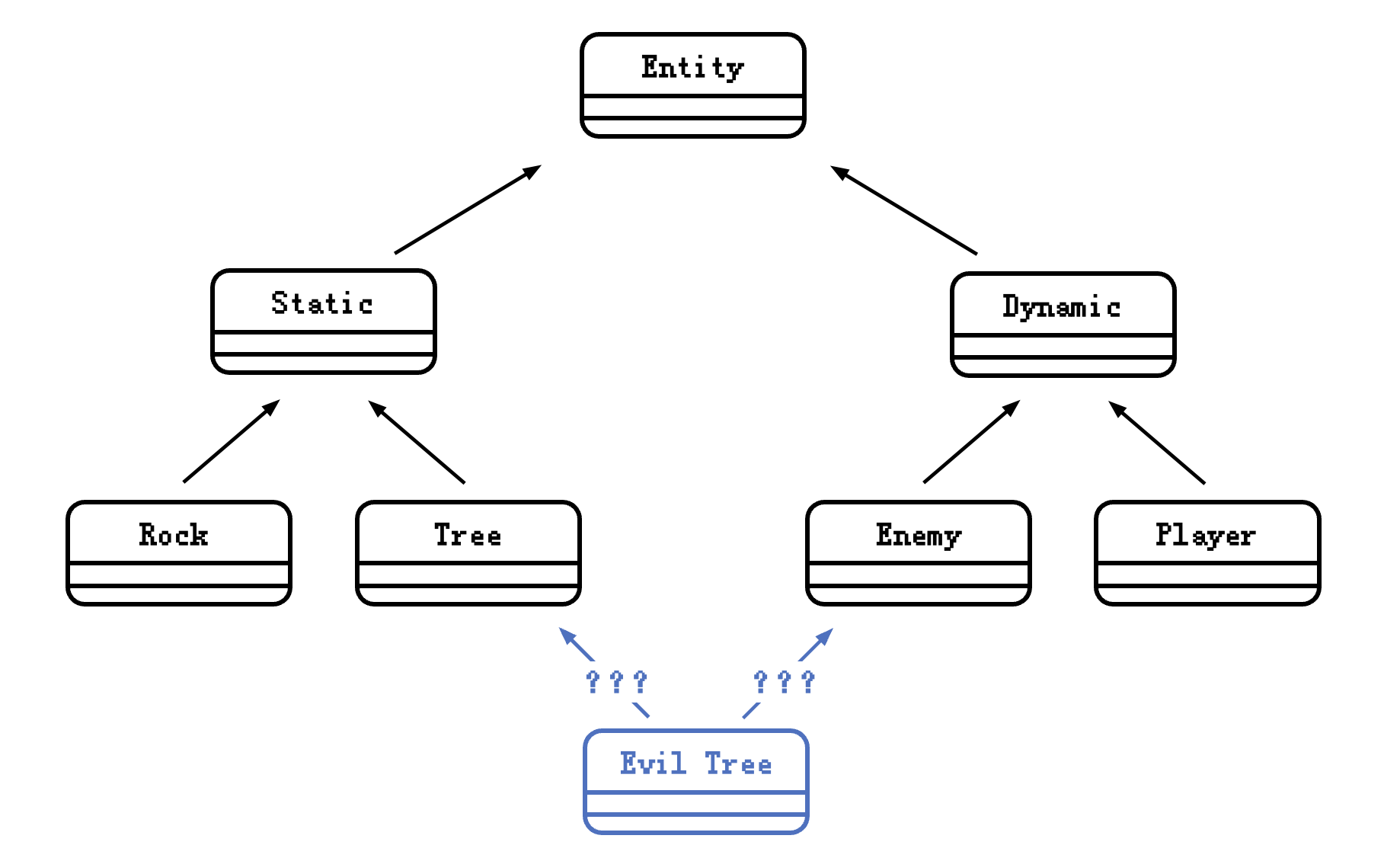
And the ECS implementation:
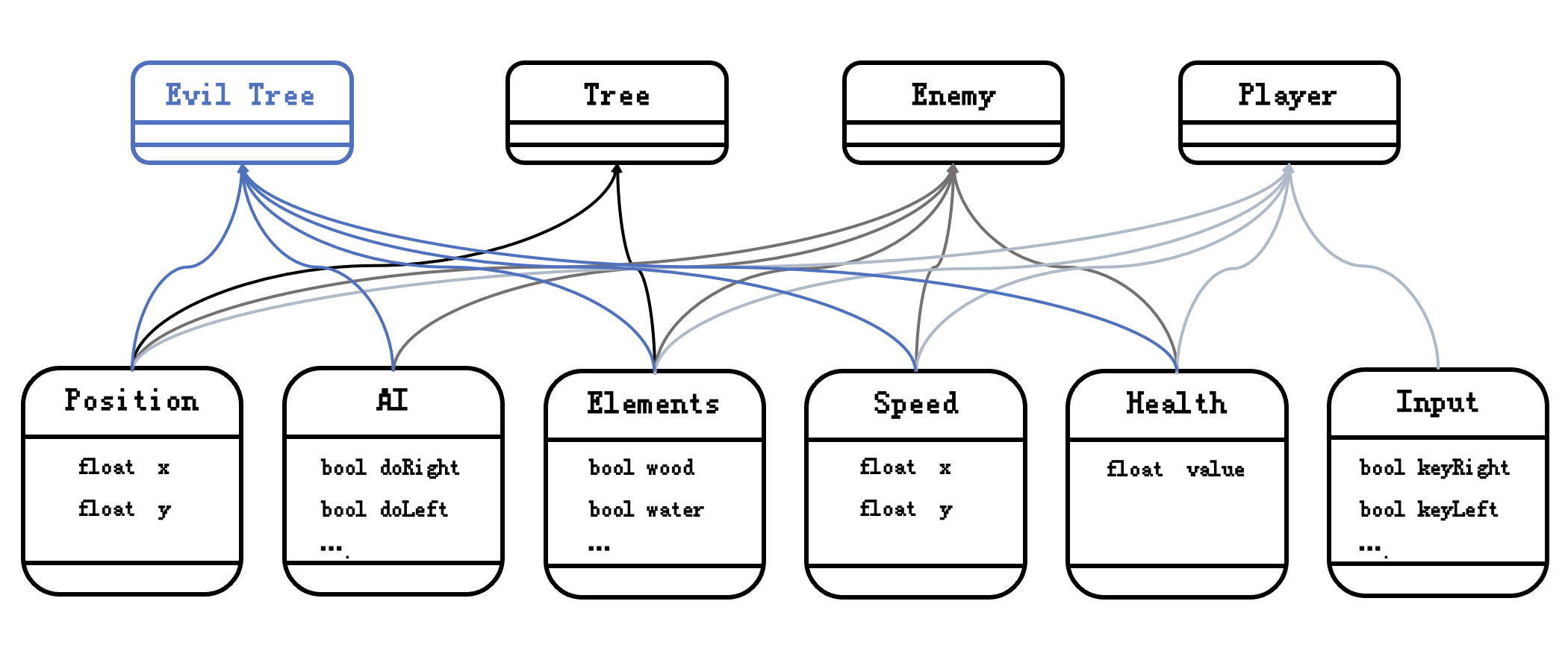
From this, it's clear that ECS is a highly modular data management framework. This 'Entity' design allows game designers to adjust game logic without depending on programmers each time, and relationships between entities can be more easily modified later.
Simultaneously, to some extent, Ethereum's network has a similar design. If we change Entity to EOA, Component to Asset, and System to Contract, we will find that each EOA has different Assets, and the interaction of Assets is achieved by calling Contracts. This mirrors how Entities have various Components, and the interaction of Components is achieved by calling different Systems.
Of course, the designs of the two cannot be entirely equated, but it's evident that this framework has good adaptability in an environment where smart contracts are the feature set. This might be one of the reasons why almost all fully on-chain engines adopt the ECS framework, with the most notable being Mud and Dojo.
III. MUD
3.1 Background of MUD
MUD first surfaced at DEFCON in Amsterdam in April 2022 and was officially launched by Lattice Studio on November 22, 2022, in their official blog.
3.1.1 Ethereum Pureblood
The background of Lattice is very worth noting. Lattice is a project under 0xPARC. And 0xPARC was initially founded by the pioneers of fully on-chain games, the Dark Forest team, among other projects. Its vision is to support and catalyze innovation in cryptographic technology at the application layer, while also being an organization actively promoting the development and popularization of zk technology in the Ethereum ecosystem (another being PSE).It receives direct donations from multiple organizations, including the Ethereum Foundation and Gitcoin.
As the energy 0xPARC is currently investing into Dark Forest has essentially dwindled to zero, and Lattice, as the advocate of Autonomous Worlds (to the best of my knowledge), can be considered to have inherited the exploratory spirit of Dark Forest in this field. Moreover, gaming is a vital and highly compatible part of the application layer, making it an ideal medium for technological innovation.
Thus, purely from the standpoint of lineage and strategic position, MUD, to the current fully on-chain games, is what Dark Forest was to the fully on-chain games of two years ago, or even surpasses it, as an insurmountable mountain.
3.1.2 Completing the Infrastructure Puzzle
Let's digress a bit and return to the origins of MUD. The Ludens’ team began experimenting with the development of fully on-chain games as early as May 2021 (initially a JRPG called Amber, which can be considered an early prototype of SkyStrife). However, they found that the existing Dapp structure and DeFi codebase were incredibly challenging to use.
In simple terms, the experience of using them was far inferior to employing OOP in traditional games. Consequently, they were forced to optimize many existing code libraries while adding new rules and entities tailored to gaming scenarios. But that's not a sustainable solution.
Reflecting on the development of traditional games, it's clear that game engines, as foundational infrastructure, played a pivotal role. They enabled creators to implement greater creativity at a lower cost, propelling the gaming industry into rapid and vigorous growth. As a new creative environment, blockchain has yet to see the emergence of a relatively mature tool, let alone a presentable framework within the entire EVM ecosystem. Hence, Lattice decided to build this critical piece of the puzzle themselves.

3.2 MUD V1
MUD V1 is essentially built around the ECS framework, mainly addressing three critical issues in developing fully on-chain games: contract and client state synchronization, on-chain content updates, and interoperability with other contracts. So, how do they solve these three problems?
A vital concept in MUD is the World contract, which can be simply understood as the game's core server. Each game/project can deploy its own World contract, and each Component is a new contract that gets registered under the World contract upon deployment. Whenever a Component is operated, its state is updated under the World contract.
With the existence of the Entity, it only needs to ensure that the client-side Entity identifiers correspond to the on-chain Entity identifiers to achieve state synchronization by merely listening to World contract events. And the indexer provided by MUD will handle the listening part, so developers do not need to write extra codes. With this World contract setup, MUD effectively solves the issue of on-chain synchronization.
Simultaneously, the ECS framework is a model that separates data (Components) from logic (Systems), ensuring that subsequent content updates or logic changes can be implemented without necessitating massive contract redeployment and subsequent data loss. For instance, when the supply rate of a resource needs to change from 10/minute to 50/minute, only the corresponding System contract needs to be updated and redeployed. As the System does not store data, there is no need to migrate the original data state, ensuring the efficiency of continuous content updates.
Regarding interoperability, all on-chain contracts are theoretically interoperable; the challenge lies in the universality of interfaces. MUD provides a universal interface through a standardized data structure and a decoupled data and logic framework. Anyone can easily read any Component state in any World contract and deploy corresponding System contracts to implement interoperable behavior.
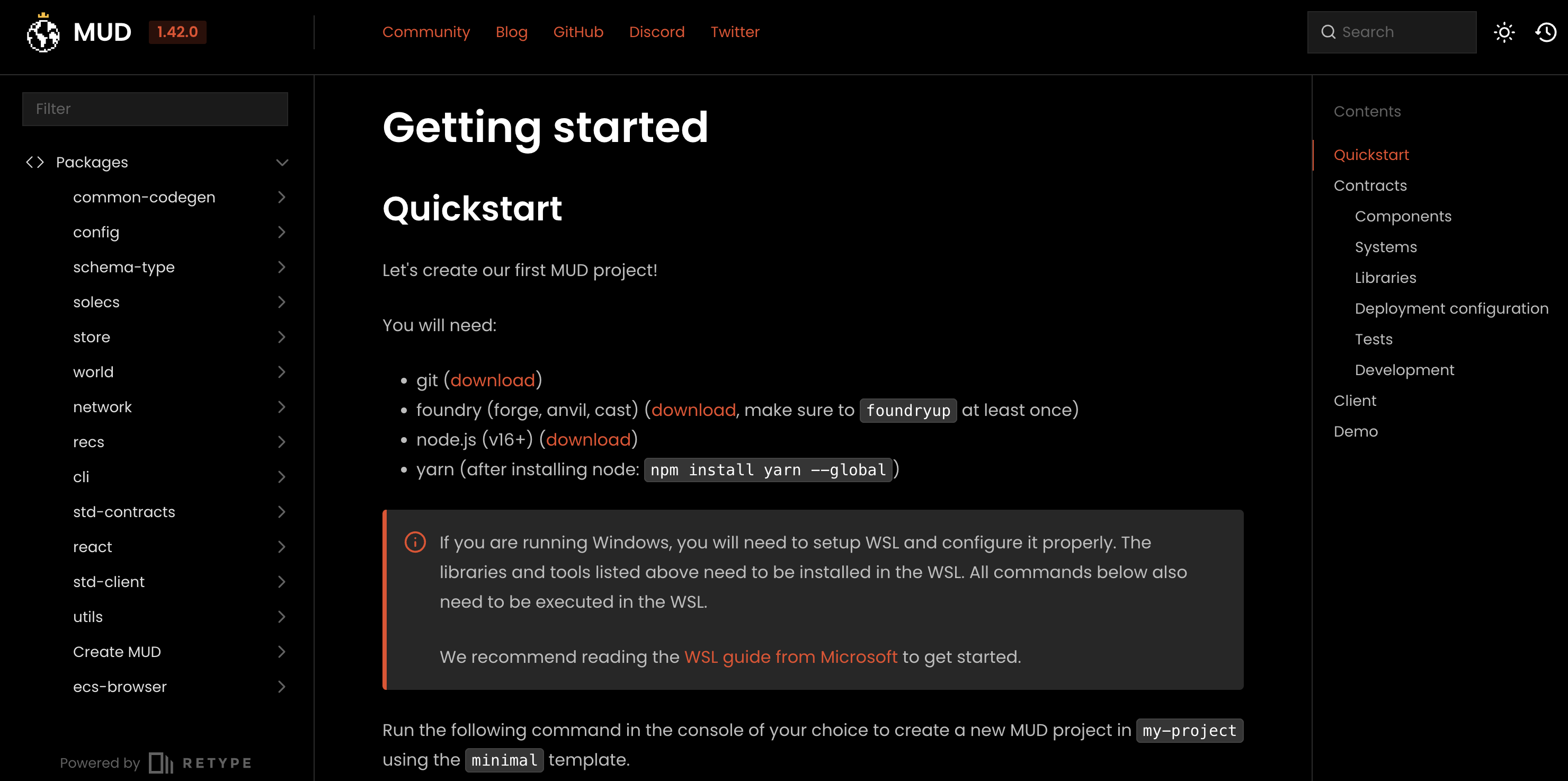
3.3 MUD V2
While most people's initial impression of MUD might be a "fully on-chain game engine on EVM," this is only partially accurate. From Lattice's public presentations, it's clear that MUD's ambition extends beyond being merely a game engine. It aims to become the missing Framework in Ethereum - an engine for all on-chain applications, the Ruby on Rails on EVM.
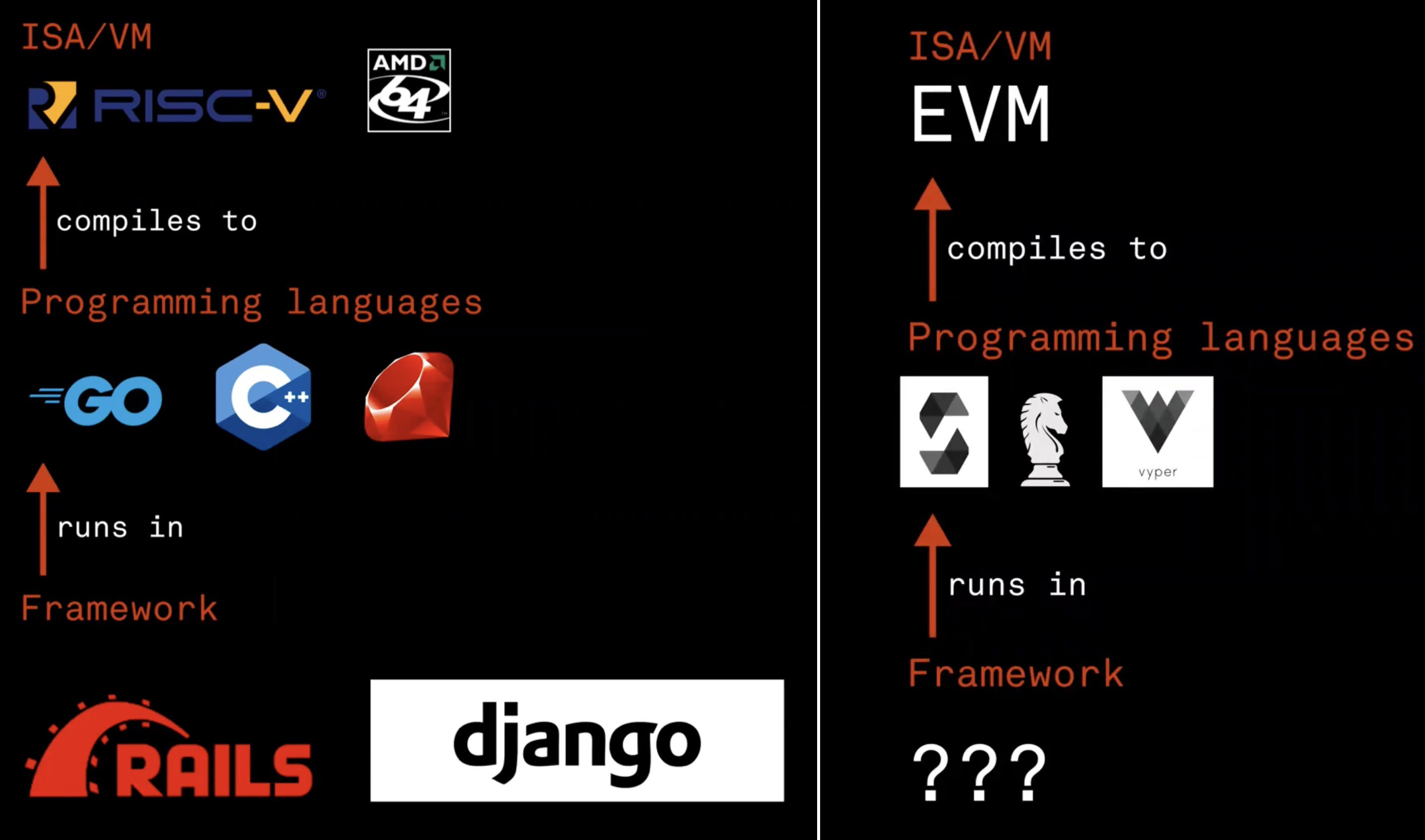
To achieve this, MUD needs to offer higher compatibility and not be constrained by a single data structure. Hence, in the MUD V2 Alpha Version released on April 1st, MUD has revised its structure and emphasized that it is not exclusively characterized by ECS.

To implement this, two essential adjustments in MUD v2 need to be mentioned:
1. Components → Tables
The most significant change is shifting from the key-value Components setting to a more inclusive Tables setting. In MUD V1, developers had to adhere to the ECS data structure, but in MUD V2, the form of data structure will be entirely up to developers, with MUD still providing the ECS library for use.
2. Component Contract → World /... / Table.sol
At the same time, while maintaining the decoupling of data and logic, the storage form of data has also changed. In MUD V1, each Component was stored and access-controlled as an independent contract. In MUD V2, the new Table version no longer requires deploying new contracts; instead, it can dynamically create tables through Solidity and store them in the World contract, much like a real database.
MUD V2 development is still a work in progress, and the final version will be subject to official documentation. For more insight into MUD V2, the Justin Glibert's Introduction to MUD 2 video might be helpful.
IV. Dojo
4.1 Origins of Dojo
Interestingly, the earliest engine concept on Starknet originated from Dope Wars. In September 2021, Dope Wars began developing an engine called Roll Your Own (RYO) to build its gaming ecosystem. Although this may be the first "engine" concept proposed in a fully on-chain game, it remains relatively unknown as it is not a generalized engine. Subsequently, several active projects on Starknet, such as Loot Realm, Topology, Influence, Cartridge, and Briq, began to independently develop around the concept of the Autonomous World/Eternal Games.
The emergence of MUD unquestionably breathed new life into the idea of a fully on-chain Autonomous World. Simultaneously, with the launch of Cairo 1.0, many contracts developed based on Cairo 0 needed to be rewritten, providing an excellent opportunity for these independent projects to restart and collaborate on Starknet.
Shortly after Starknet announced Cairo 1.0 in November 2022, Loot Realms' core contributor @lordOfAFew, Cartridge founder @tarrenceva, and Briq founder @sylvechv proposed the idea of developing a fully on-chain game engine on the Starknet. By February 2023, Dojo was officially established.
Since MUD was the only available reference at the time, and given MUD's impressive design and performance, Dojo's early development revolved around implementing MUD's principles in Starknet's Cairo language (in the very early stages, and Loaf openly admitted this, leading to the saying that Dojo is a ported version of MUD, a claim that slightly irritated MUD founder Ludens). However, with the release of MUD's V2 attempting to break away from ECS, Dojo has also begun exploring its own unique path towards a Fully On-Chain Engine.
4.2 Why Cairo
When discussing the need for a Cairo version of the game engine, we must consider what advantages Cairo has over Solidity for fully on-chain games. To answer this question, we can draw some insights from the views of Dojo's core developer tarrence.eth based on his thread.
Firstly, Cairo is a Turing-complete, Rust-like language used to create provable programs for general computation, boasting some unique features:
1. Proof recursion
Cairo-generated proofs are recursive, meaning you can prove the verification of a proof. If you need to prove that a series of computations are valid, in Solidity, you need to provide the entire computation sequence as proof; whereas in Cairo, you can create a proof and verification for each computation, then create a proof to verify all individual verification results, achieving extremely high computational compression. This is crucial in applications like games with high interaction frequency.
2. Incremental proof
Cairo can break down an execution into several smaller parts, each of which can be proven independently. For instance, some verifications can be placed on the client-side to conceal user input and then verified on-chain, ensuring the privacy protection of sensitive data and higher resource utilization efficiency. This means that asymmetric information games can be realized while ensuring core game logic is on-chain.
3. State differences
After a Cairo program is verified, two artifacts are generated: execution trace and state difference, with the latter describing the state transitions during a computation. Unlike Optimistic and some other Rollups that choose to put an execution's "input" on the DA layer, Cairo can put an execution's "output" on the DA layer.
For games, this also greatly improves verification and storage efficiency. For instance, in a three-minute chess game, there may be 50 move executions. If using Optimistic Rollup, the state "input" for each step is required; whereas in Cairo, only the game's final state and the state differences are needed.
This ability to compress inputs into the program enables many exciting features, such as using middleware like @HerodotusDev to allow players to participate in Starknet games using assets from other chains.
4. General-purpose
Unlike Solidity, Cairo's generality allows it to be used for a broader range of applications beyond blockchain, including creating provable programs for cloud computing or edge devices, providing it with greater scalability.
In addition to these features, Cairo has many other characteristics that make it more efficient and scalable than Solidity, better suited for handling large amounts of computation. This is a distinctive advantage for applications like games with high-frequency interactions and sensitivity to latency.
However, the development of fully on-chain games does not solely depend on the underlying language efficiency. At such an early stage, the overall ecosystem's environment and maturity play a vital role.
Next, we will explore the ecological development of fully on-chain games through the ecosystem maps represented by MUD for the EVM and Dojo for the Starknet.
V. Ecosystem Map of Fully On-chain Games
5.1 MUD Eco
As mentioned earlier, MUD is undoubtedly the pioneer of the EVM ecosystem, being the first to propose the concept of the Autonomous World and fully on-chain game engine. As a result, it has a natural appeal and cohesion within the developer community. From the 4-week Autonomous Worlds Winter '22 Residency held by 0xPARC in 2022, many groundbreaking fully on-chain games developed around MUD have emerged, including Dark Sea, Crypto Town, Lattice's self-developed OPCraft, and Sky Strife.
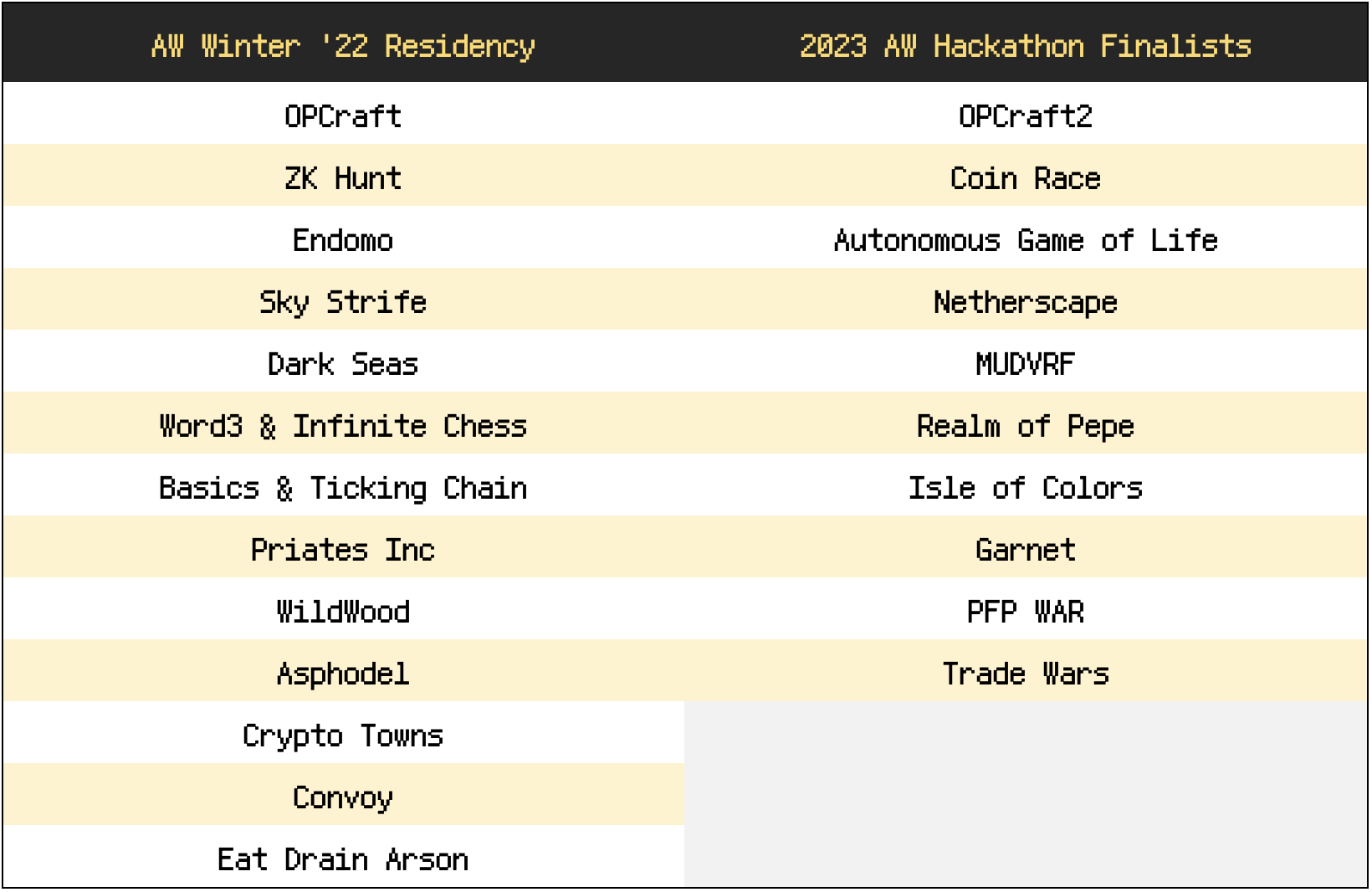
I will highlight a few intriguing projects from the '22 Residency and this year's Hackathon Award Winners to provide a brief overview, offering a better understanding of the current state of MUD games:
① OPCraft 1 & 2
First up is OPCraft, which, along with Sky Strife, is one of the earliest officially announced games. As the name suggests, Optimism's OP Labs team also co-developed the game. OPCraft is a Minecraft-style 3D voxel sandbox fully on-chain game.
The team completed the initial game development using MUD in less than 2 days and launched the earliest test version after about two weeks. This earliest, and perhaps most representative Autonomous World fully on-chain game, achieved 1500+ participating players, 3.5 million+ on-chain transactions, various large-scale voxel structure creations, and 5+ player-made plugins within two weeks of launch.
Speaking of the embodiment of the Autonomous World concept, one cannot ignore the entirely player-initiated, contract-managed social structure "OPCraft Autonomous People's Republic" that emerged during the earliest testing period.
OPCraft allows players to perform 6 actions, 4 of which are in-game: destroying blocks, crafting blocks, placing blocks, and claiming a 16x16 piece of land (by becoming the highest diamond staker for that plot). The other 2 actions are customizing the front end and deploying custom components and systems.
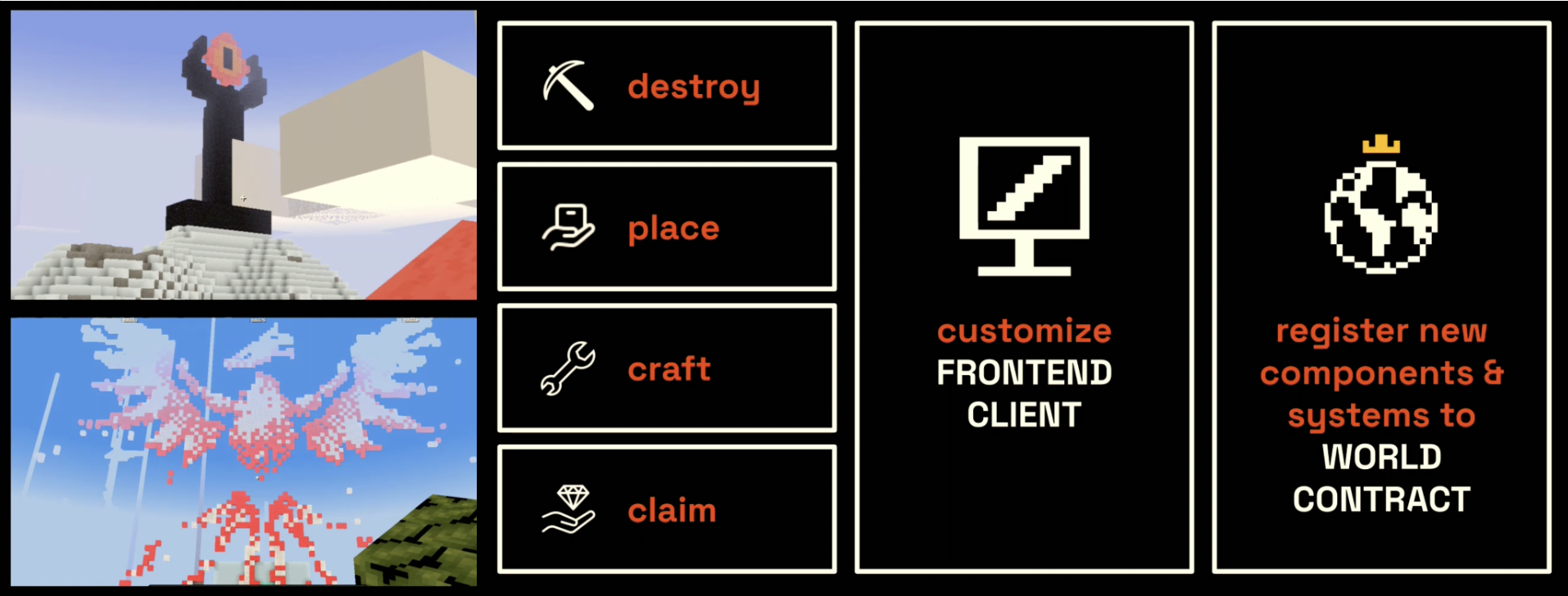
In the game's early stages, players were keen on digging huge holes in the ground to trap other players, or building large-scale artistic structures similar to Minecraft. Various plugins were mainly focused on resource mining, in-game social, and different visualizations until the emergence of a "Supreme Leader."
One day, the "Supreme Leader" suddenly appeared, claiming almost all the plots around the spawn point using a million mined diamonds, preventing other players from building or mining on them.
Simultaneously, they created a "comrade" system contract: players who chose to join the republic as comrades had to give up all their personal property, which was confiscated into a public treasury. In return, players gained the right to use all assets in that public treasury and build and mine on the republic's land. In the process, players had to mine more resources than they used, establishing a fully autonomous nation.
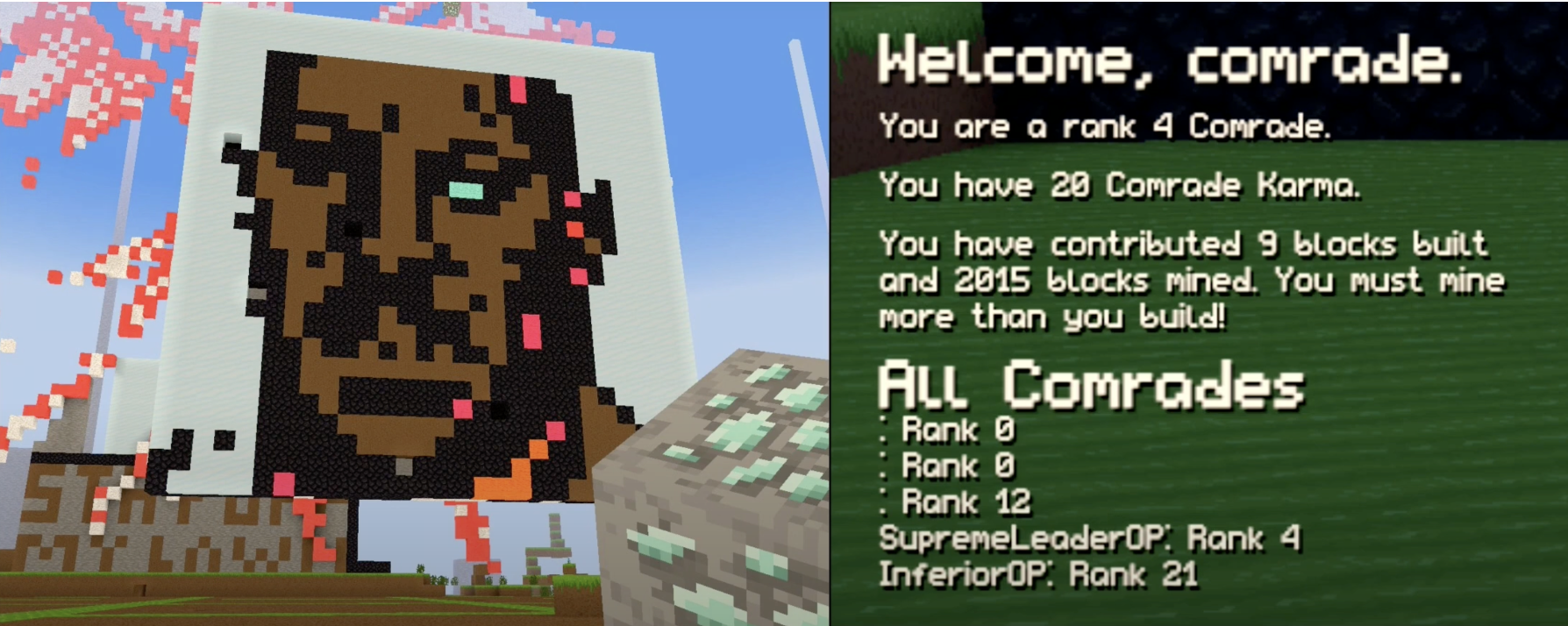
The emergence of such a nation was entirely beyond the official team's expectations. It was 'simply' realized in just 3 steps: a "comrade" component, a "governance" system, and a frontend plugin linking the two.
In the recently announced OPCraft 2 at the AW Hackathon, the team unveiled a new standout feature - the "Redstone System".
Players familiar with Minecraft should understand the creative potential of "Redstone," as different logic gate components built with binary input can create an operating system. Although the hackathon demonstration was relatively basic, its features were well demonstrated, and its future development is highly anticipated.
② Sky Strife
Sky Strife is an RTS game developed by Lattice, essentially serving as a prototype for subsequent fully on-chain turn-based games. It is the most content-rich, smoothest, and competitive turn-based fully on-chain game that I have experienced so far.
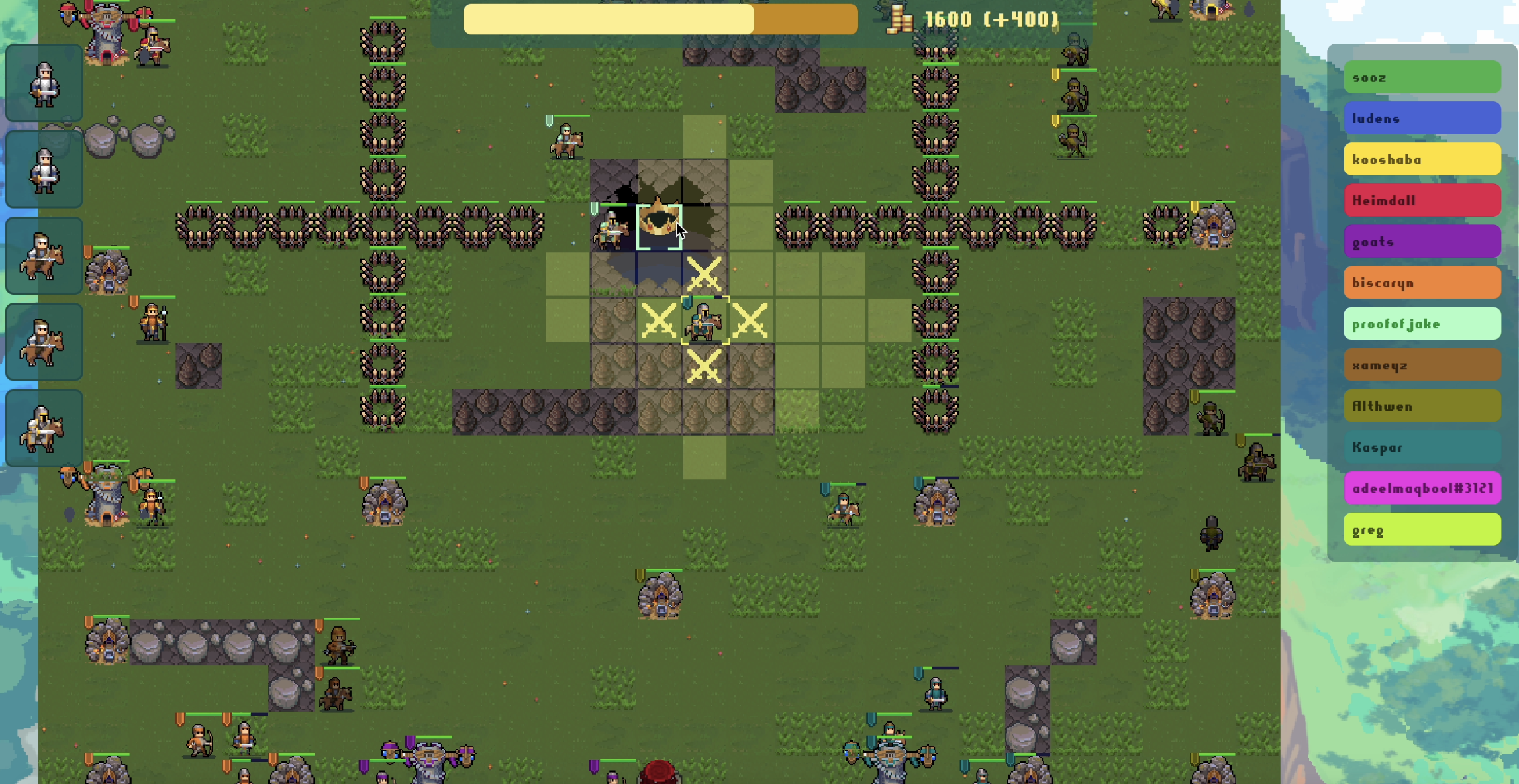
The early game primarily focuses on the capture-the-flag mode, where players need to deploy troops, expand their influence by occupying different resources on the map, and seize the crown in the center of the map. The player who ultimately escorts the crown to the exit portal wins. In this process, players need to make strategic decisions such as troop allocation, terrain resource utilization, and the relationship dynamics among different clans.
The earliest game experience can be seen in this tweet. However, with several versions of iterations, the game's pace, and many settings have been well-balanced, making it quite enjoyable to play. For a detailed introduction, check out this official guide.
In recent updates, the team has redesigned the game's UI, introduced the hero, and added a "battle royale" mode. The overall development progress is quite promising. I highly recommend joining the Lattice official Discord and playtesting for a hands-on experience.
③ Autonomous Game of Life
Autonomous Game of Life is a finalist at the AW Hackathon, developed by @Komorebi8888 and @yamapyblack. Using the MUD v2 engine, they not only brought Conway's Game of Life to the fully on-chain realm but also developed a cellular automaton template, allowing anyone to quickly build their cellular automaton models.
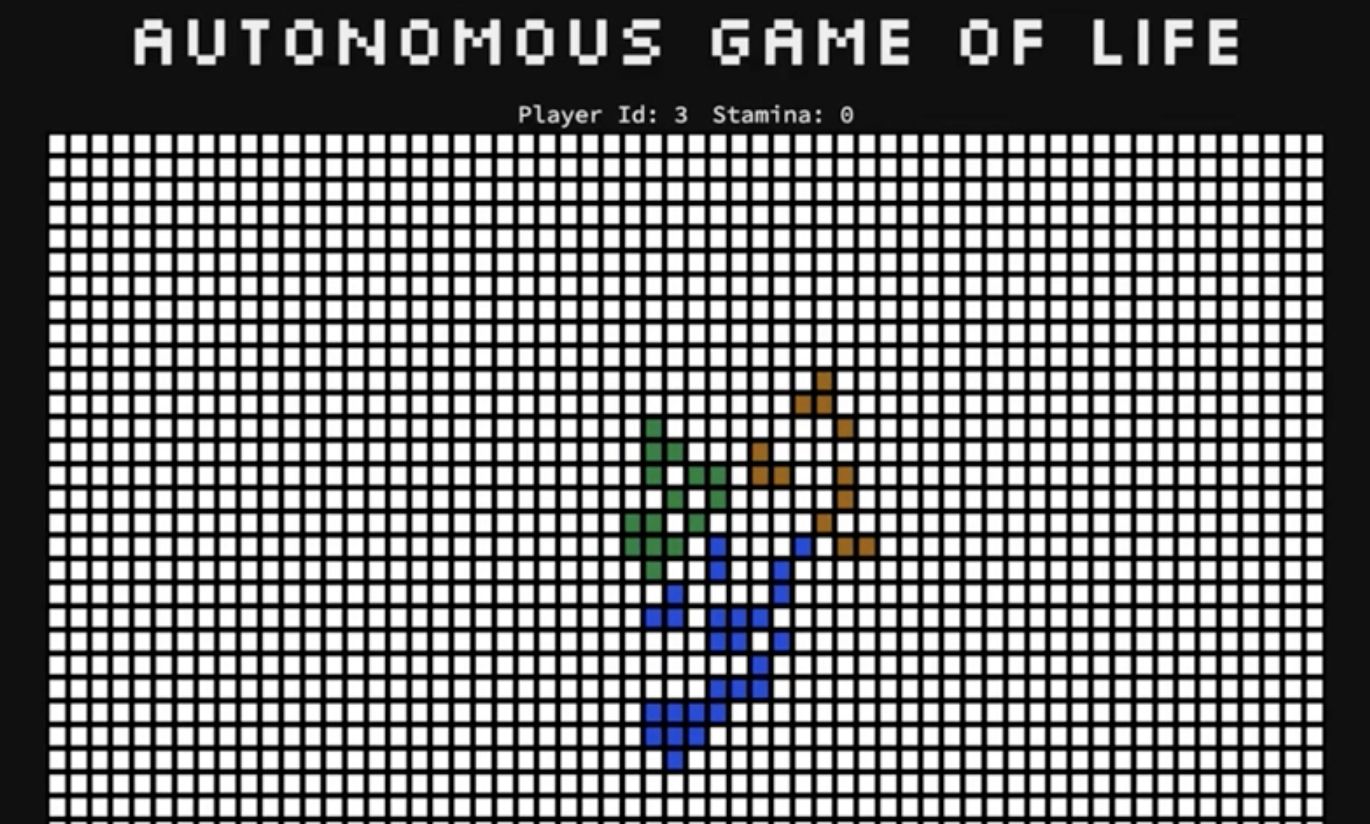
In Komorebi and yamapyblack's version, players can compete against each other. Players need to set initial life patterns by arranging cells, which then perform random walks. When cells come into contact with other players' cells, the cells with more allies surrounding them survive, and the last-standing cells are determined as the winner.
Unlike common game genres, the Game of Life is a unique category with a relatively mature ecosystem of its own. When it enters the fully on-chain world, it is exciting to anticipate what kind of chemistry it will create in the future.
④ Netherscape
Netherscape is a fully on-chain RPG game developed by @DFArchon. It is not only a finalist at the AW Hackathon but also received the Most Creative Use - Gold Award from MUD.
Netherscape refers to player-controlled characters as PCs (Playable Characters). Through MUD's ECS framework, each PC is constructed as an entity embedded with many components and systems, allowing players to control PCs for exploration, crawling, combat, and crafting. This also enables not only the team but third-party developers to create more complex interaction rules, such as market trading systems, combat enhancement systems, new maps, and more.
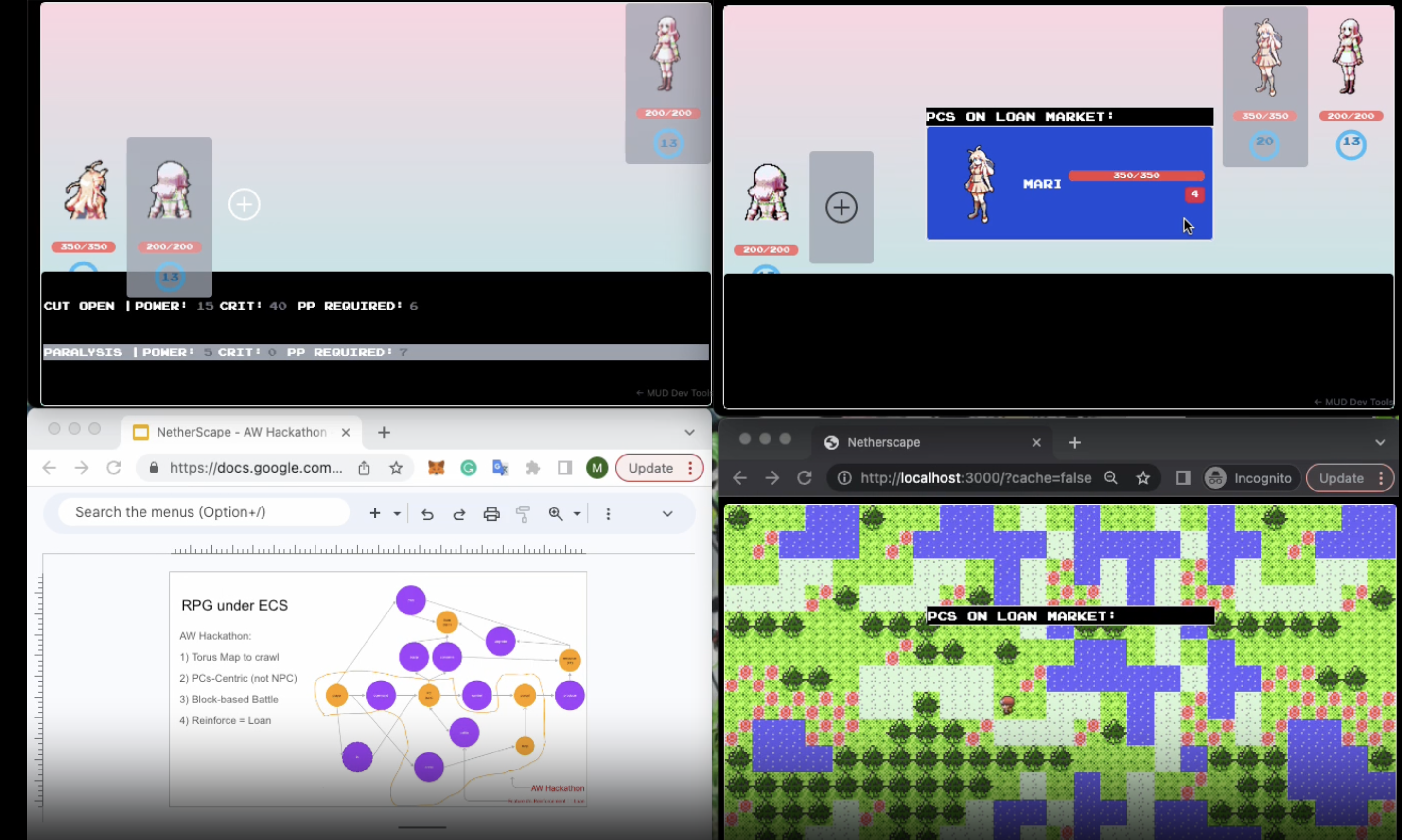
Interestingly, since the power to control PCs is abstracted into a component, players can trade and lease PCs with each other. In the demo, the founder @BriefKandle demonstrated a quick lease operation during a battle.
This mode is quite common in modern mobile games, lowering the entry barrier for newcomers in the context of higher complexity, while also enhancing the in-game social experience. It is a beneficial implementation for fully on-chain games, and we eagerly await the official launch of the game in the future.
⑤ Realm of Pepe
Realm of Pepe is an intriguing experimental fusion of fully on-chain gaming with streaming payments. It is also a finalist at the AW Hackathon, supported by Superfluid.
This ARPG game boasts an attractive art style, although the game content is still quite basic. When players create characters, an upgradable NFT Profile is generated to record the player's status. As players interact with map resources, the Profile is updated, and when specific requirements are met, the next level is unlocked.
The overall game logic is simple and straightforward. The more fascinating aspect is the use of streaming payments for resource distribution. Although it is recorded on NFTs in the game, tokenizing some special resources and distributing them to players via streaming payments may have a positive effect on the overall resources and economic system of fully on-chain games, particularly for MMORPGs or STGs.
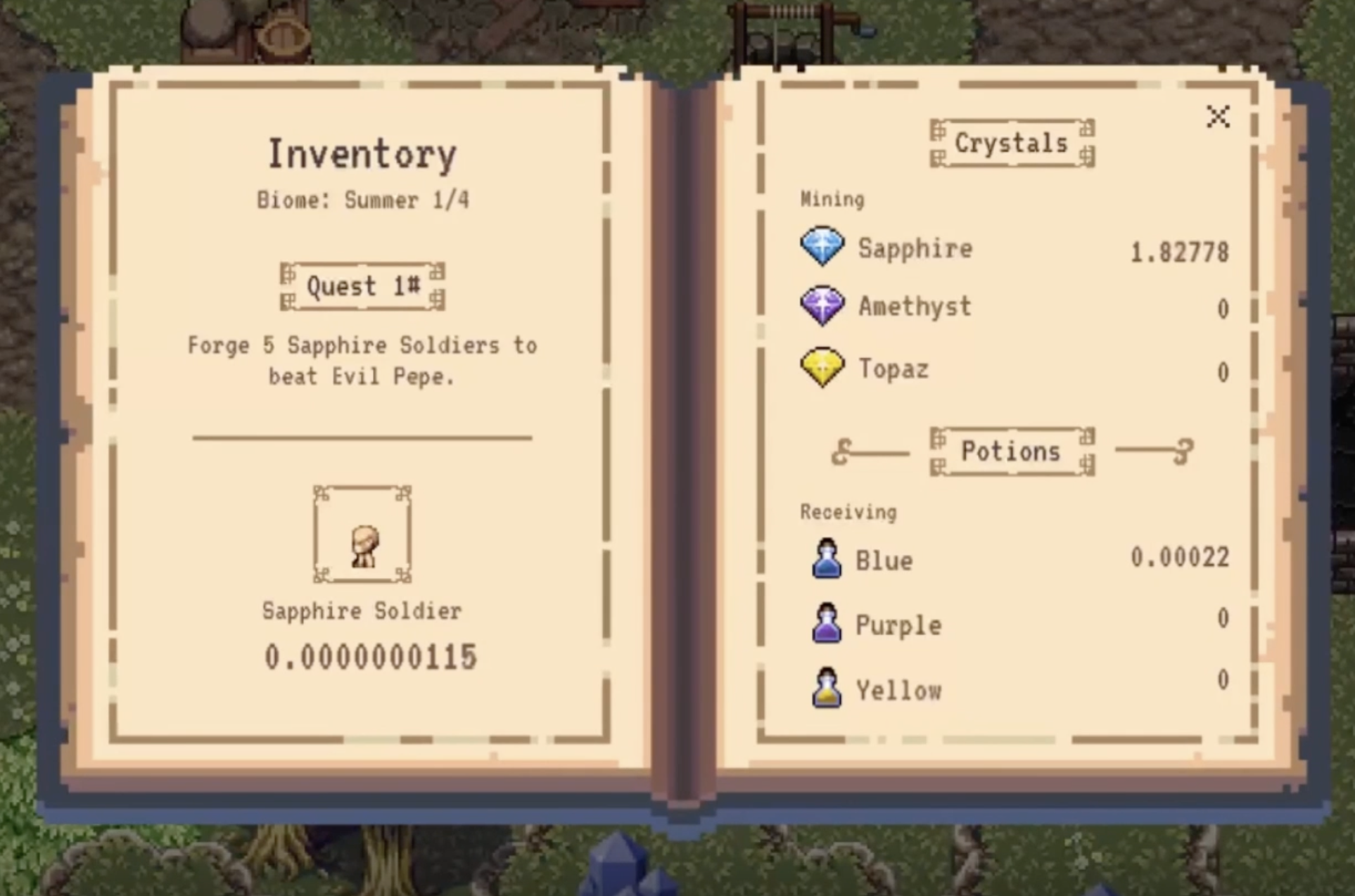
Due to the length, it's challenging to elaborate on all other projects from the AW Hackathon. Many interesting and inventive ideas have emerged during this hackathon, with numerous attempts to combine with various concepts, such as Layer, Mud Social Plugin and Werewolf, Courtroom, GPTMud, Agent Arena, and more.
In fact, besides this hackathon, there are also lots of interesting games developed around MUD, such as Word3 by 0xSmallBrain and his new work Network State developed in collaboration with 0xhank and Moving Castle; Rhascau by stokarz, Muddy Frost and Museum Heist by Tetration Labs, and Primodium, a Factorio-like game developed by the former Critterz team members tax cuts and Emerson Hsieh. All of these projects are worth following.
Lastly, for those interested in the MUD ecosystem, it's essential to follow AW House, initiated by Komorebi. They are currently accepting applications for AW Impact Grants and recruiting for Hacker House during the 2023 ETHCC.
5.2 Starknet Eco
As previously mentioned, during the Cairo 0 era, fully on-chain games in the Starknet ecosystem were mostly independently operating with some collaboration. With the announcement of Cairo 1.0, a large number of contracts required rewriting, and the emergence of Dojo provided an opportunity for a united front for various games. However, as not much time has passed, previous games like Dope War, Influence, and the recently released Loot Survivor are still being remade using Dojo for Cairo 1.0, so the Dojo ecosystem has not yet surfaced.
Therefore, we use the term "Starknet Eco" for better summarization. Moreover, the core contributors of Dojo are mainly active contributors from the Starknet ecosystem, and the term "Starknet Eco" might continue to be used in the future.
Considering that each project in the Starknet Eco has a rich history, we will start with the introduction of the teams behind each project, beginning with the "Three Origins" of the Dojo engine: Realms, Cartridge, and Briq.
5.2.1 BibliothecaDAO
First up is the development team behind Loot Realms, BibliothecaDAO, an active and significant organization in the Lootverse. I previously introduced this team in more detail in my article ”The Ultimate Form of Blockchain Gaming: Exploring 'Fully On-Chain' through Dark Forest & Loot“.
Loot (for Adventurers) was an experimental project launched by @Dom Hofmann on August 28, 2021. Owing to its bottom-up, community-driven autonomous growth characteristics, it has high malleability and nearly unlimited possibilities, attracting many contributors. Numerous derivative projects emerged in a short period.
However, as the speculative fervor subsided, most of the projects vanished, while Loot Realms, also a community-driven project, has been actively contributing to the Lootverse since its launch on September 1, 2021. Core contributors @lordOfAFew, and @TimshelXYZ have become almost spiritual leaders within the Loot ecosystem.
If the underlying narrative of Loot has been built into a 'Game of Thrones' through the contributions of Timshel and many other members, then Eternum, the first project of Realms, would be the 'Game of Thrones' version of 'Civilization V', carrying the entire lore and narrative.
Driven by BibliothecaDAO, Loot is no longer just a text-based IP but offers a wider range of interactions. However, as a game, it also faces the inherent performance challenges that all blockchain games encounter.
Around November 2021, the team decided to migrate to Starknet for further development due to various considerations. In early 2023, they officially released the alpha version of Realms: Eternum and the first "play to die" roguelike game LootSurvivor at ETHGlobal Lisbon in May 2023. Both were among the first fully on-chain games written in Cairo 0, solidifying BibliothecaDAO's status as a veteran of Starknet's fully on-chain games.
Due to its community-driven nature, BibliothecaDAO has not sought fundraising from VC but instead opted to launch its own governance token, $LORDS, in December 2021. On February 1, 2023, they completed a community fundraising round based on the 7th community proposal (BIP-7). Thanks to the robust community cohesion, they achieved an impressive 6.35x oversubscription.
① Realms: Eternum
Eternum is a fully on-chain sandbox strategy simulation game reminiscent of "Civilization V." Even before the concept of an "Autonomous World" was proposed, BibliothecaDAO aimed to create an "Eternal Game" and initiated development soon after the NFT launch in September 2021. The name Eternum is a fusion of the first half of "Eternal" and the second half of "Ethereum."
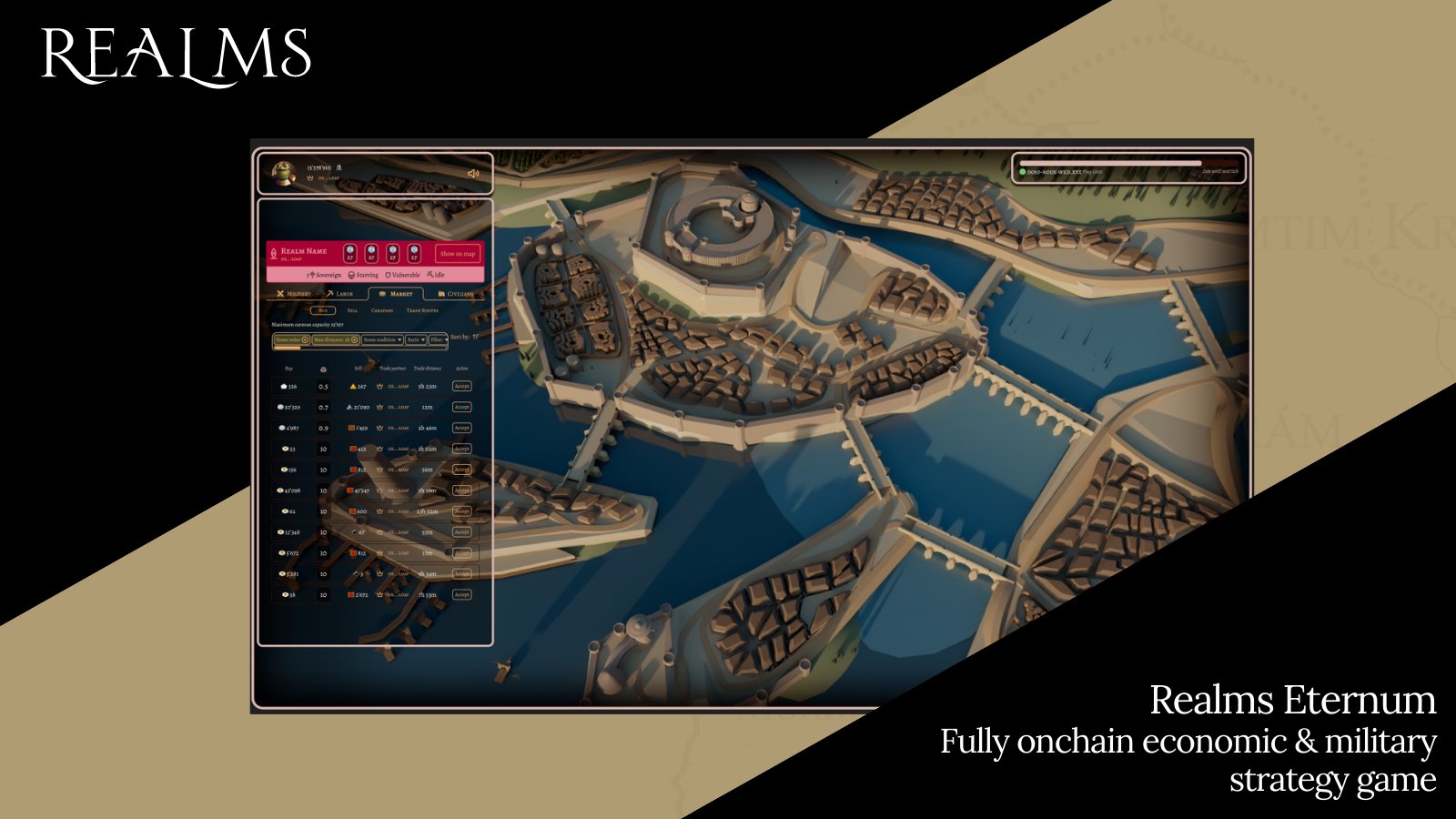
The game was initially built around the ERC-2535 diamond standard proposed in 2020 and deployed on the Arbitrum network. However, facing various challenges during development, the team realized that EVM and Solidity seemed incapable of supporting their vision of an eternal world at that time, leading them to transition to the Starknet network.
In the game, players must hold at least one Realms NFT to participate. Players act as the lord of their territory, strengthening their domain through resource acquisition and management. The gameplay involves construction, trading, conquest, and defense among players. The game launched its testnet version in January 2023, and players can try it out here.
Based on my personal gaming experience, the game already has a well-defined structure and gameplay logic. While there is room for improvement in the interaction experience and lengthy transaction confirmations, Eternum, as one of the few fully on-chain games available, showcases admirable results.
Moreover, it has a well-designed in-game economic model, seamlessly integrating with Lootverse assets and its $LORDS tokens. Upon launching on the mainnet, both Realms and C&C NFT holders will receive continuous asset output, which can be sold for $LORDS. The game has also developed an AMM market for assets, and as it further integrates with the Loot ecosystem narrative, the depth of the game could increase rapidly.
② Loot Survivor
Loot Survivor is a text-based Roguelike game, with core developers including the co-founder of Genesis Adventurers, @aloothero, and the founder of the fully on-chain game guilds protocol Guildly, @distracteddev. The game officially premiered at the fully on-chain gaming summit in Lisbon on May 25, 2023. Upon release, it swiftly gained popularity at the event, becoming the most favored fully on-chain game at the time and attracting a multitude of enthusiasts.
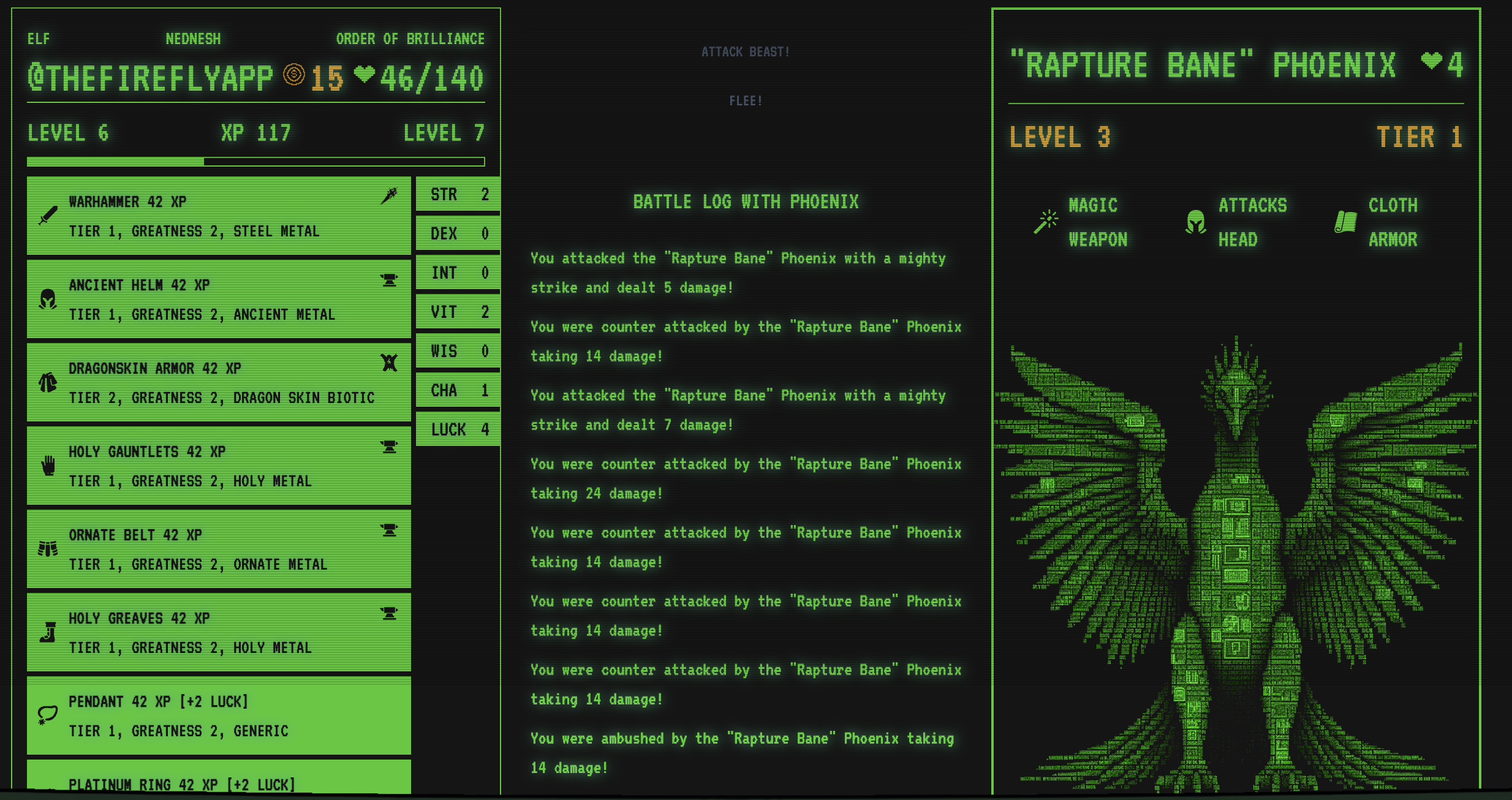
Its origins, however, can be traced back further, with the core "Play 2 Die" concept proposed as early as February 2022. Initially, the Realms team planned to develop this idea into the first expansion of the Realms series, named "Realms: Adventurers." The early game design involved using Stable Diffusion to generate player characters, with game developers designing games with series levels. If players died within a level, the lost assets would be acquired by the game designer.
In this process, the game designer had to maintain a balance in level design, ensuring that the difficulty was neither too high to deter players nor too low to prevent deaths. Players, in contrast, had to contemplate the choice between pushing their luck or cashing out. The prospect of challenging levels could lead to more spoils or the loss of everything. This mode fostered a unique, competitive dynamic between players and developers.
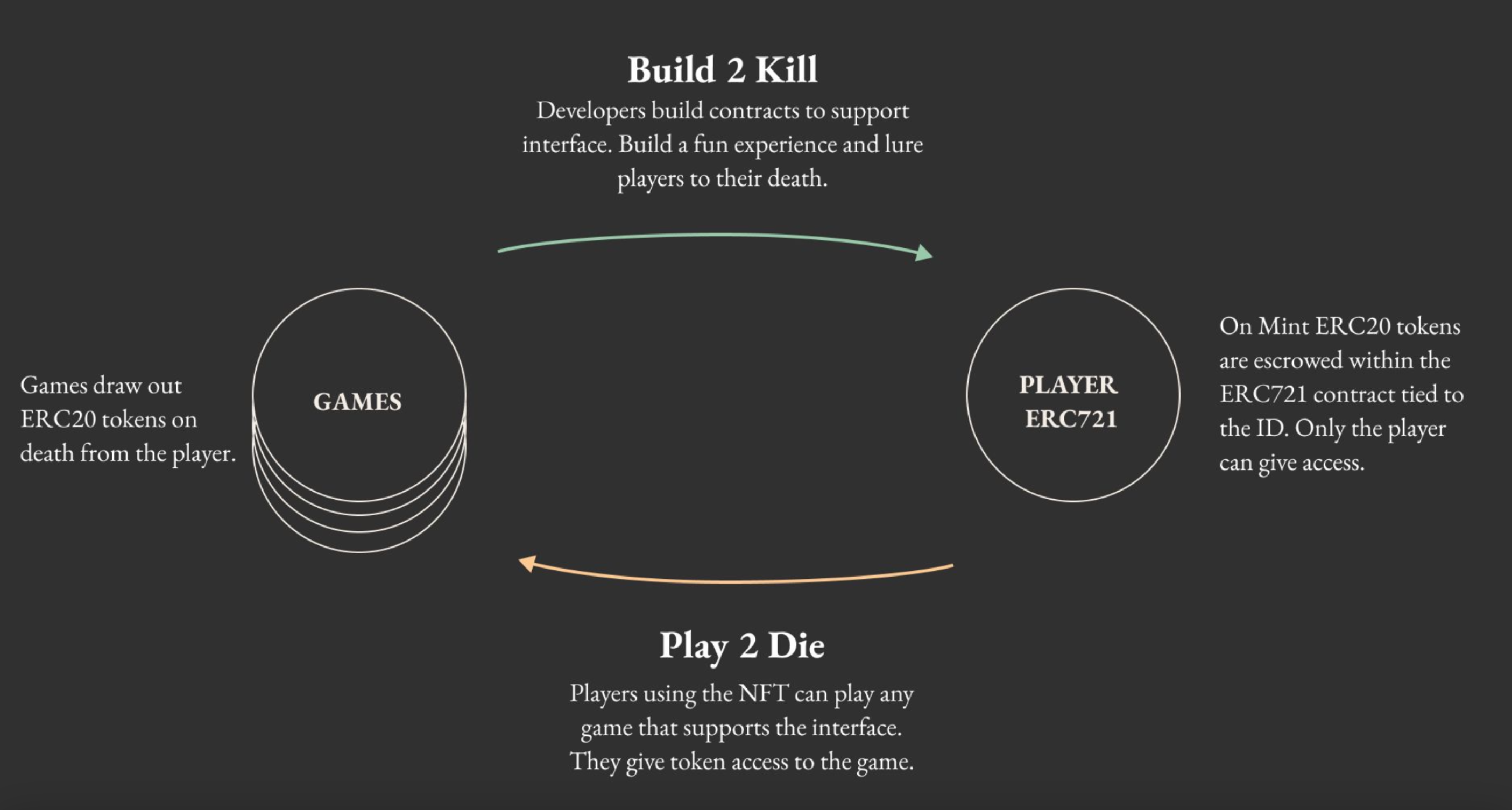
With the advent of the Dojo engine, the team's understanding of fully on-chain games deepened. During the iteration of Realms: Adventurers, the team decided to quickly create a smaller single-player fully on-chain game as a test case for the "Play 2 Die" concept. They incorporated existing cryptographic primitives, such as Loot's weapons and on-chain characters, leading to the birth of Loot Survivor.
It's worth noting that Loot Survivor's development was joined by Genesis Adventurers co-founder loothero. GA's position in the Lootverse has been briefly mentioned in previous articles, having laid much of the foundation for the entire narrative of the Loot universe. Loothero is the creator of many settings, with various factions and numerical systems in Loot originating from him.
Therefore, although Loot Survivor may not be a large-scale game, it thoroughly embodies the cultural heritage of the Loot series. It's expected that in the foreseeable future, we will witness its deep collaboration with Genesis Adventurers.
For a more detailed introduction to the game, we recommend reading this article by AW Research.
5.2.2 Cartridge
Launched on May 9, 2022, Cartridge is a gaming platform akin to Steam on Starknet, featuring decentralized identity, reputation, and game publishing. It completed its seed round funding in June 2022, with investors including Fabric Ventures, Valhalla Venture, and Chapter One.
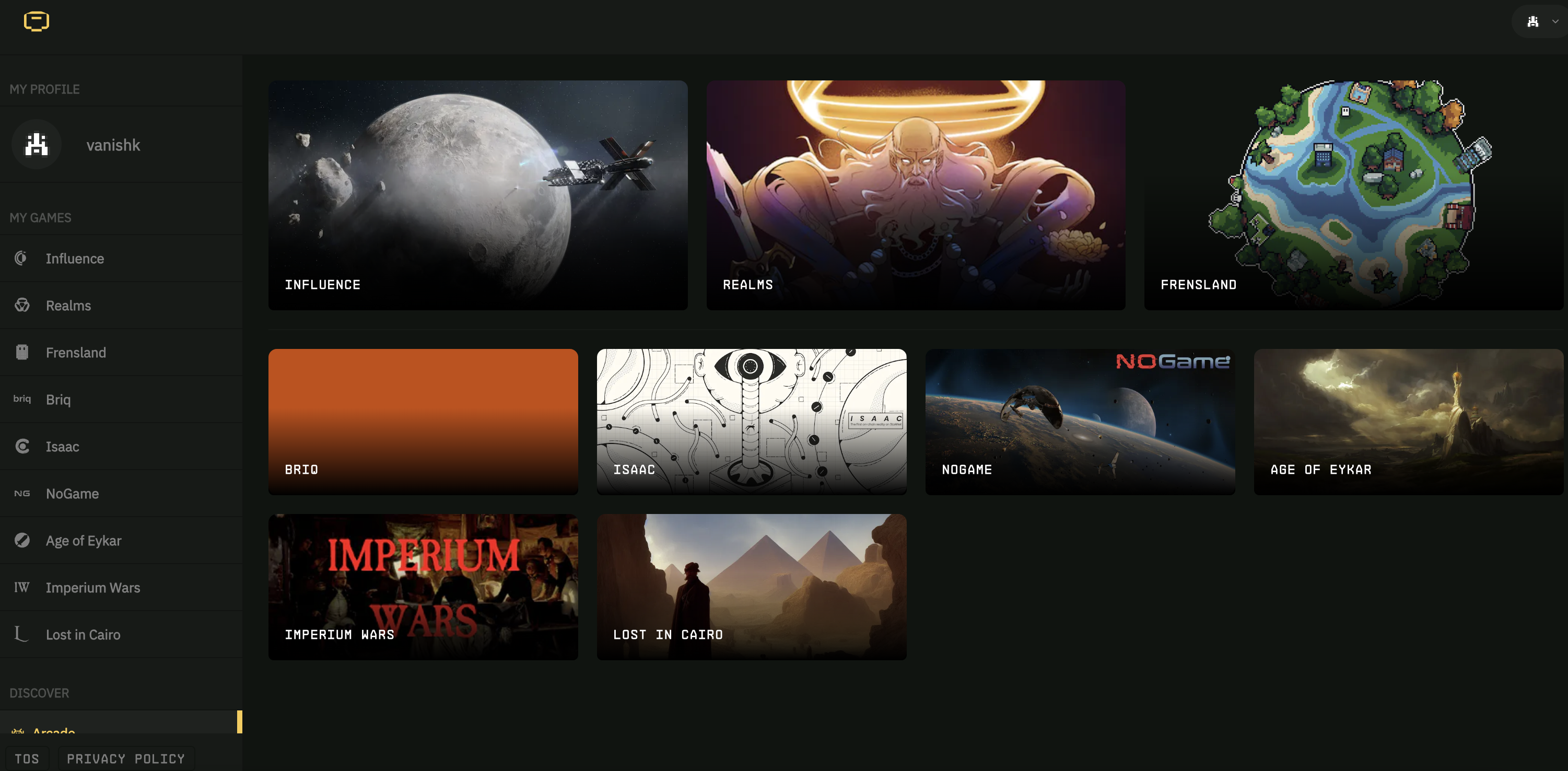
In fact, the Cartridge team has a deeper connection with the game engine, which can be traced back to another Loot-related project — Dope Wars.
① Dope Wars
Dope Wars is a significant and active derivative branch of Loot, alongside Loot Realms. Initiated on the ETH mainnet on August 31, 2021, by @Dennison.og, it is a Loot-styled Free Mint project with a total supply of 8,000. Subsequently, on September 4, 125,000 $PAPER tokens were airdropped to each NFT holder.
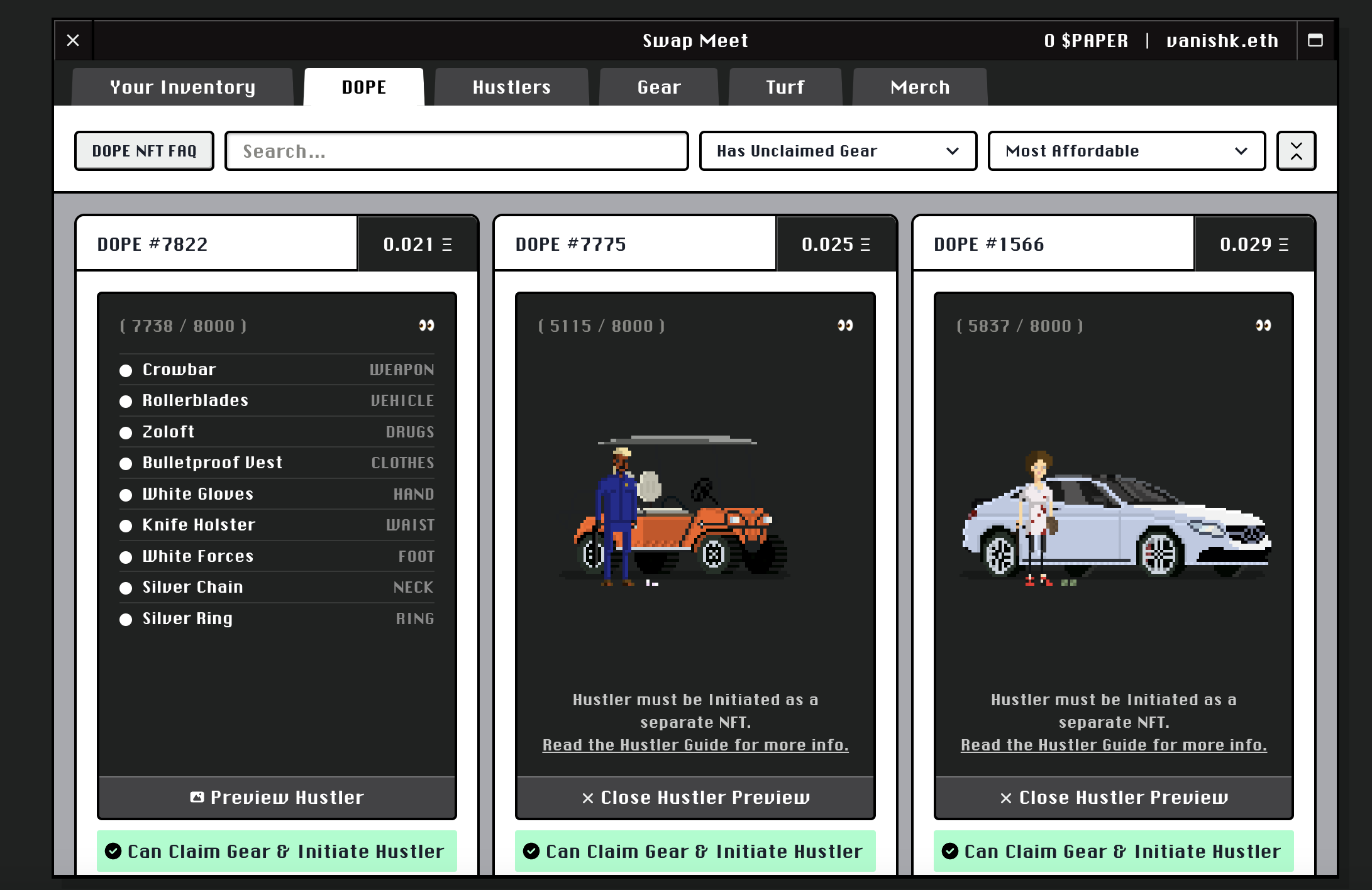
Unlike Loot's magical fantasy theme, Dope Wars adopts a GTA-like street/gangsta-style approach, attracting numerous enthusiasts upon its launch. Perhaps due to its cultural attributes, the community vibe is highly active and swiftly began developing its own game.
Influenced and inspired by the classic game Drug War, Dope Wars seeks to leverage Loot's bottom-up vision, which aligns perfectly with street culture, to construct a GTA-style game universe and achieve modular expansion through blockchain characteristics. Consequently, the first fully on-chain "game engine"—RYO entered development after passing the community's fourth proposal, initially initiated and led by @perama. Cartridge's founding team, including @tarrenceva, later became core contributors to the project.
In reality, RYO is not a universal game engine. Instead, it provided a set of modular standards and interfaces centered around Dope Wars' content at the time, enabling developers to work more efficiently within the Dope Wars ecosystem. It resembles a set of MOD development tools. This unique experience undoubtedly offered valuable insights to the Cartridge team in the realm of game engines, and as a result, they later became significant contributors to the Dojo triumvirate.
Following Dope Wars, their assets were migrated to the OP network, and a visual Marketplace was developed. Additionally, the game Dope Frenzy was launched on the Starknet network. However, as the market cooled, the game's development came to a halt.
With the advent of Dojo, the Cartridge team officially announced in June 2023 that they would remake RYO based on the Dojo engine. Presumably, the previously shelved fully on-chain version of Drug War will soon re-emerge.
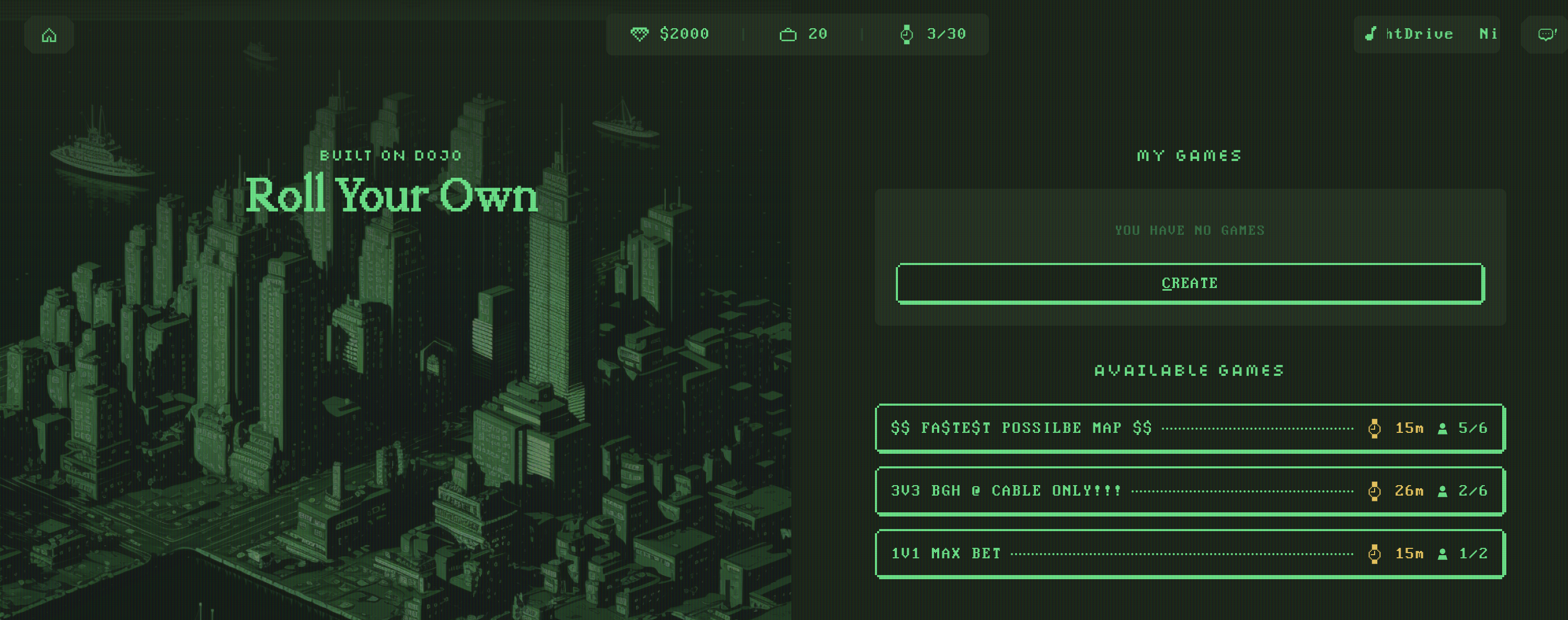
5.2.3 Briq
Briq is a Starknet project that originated in October 2021 at the ETH Lisbon Hackathon, founded by @sylvechv and @wraitii. It aims to create an on-chain LEGO system where users can assemble basic "blocks" to bring any creative idea to life and disassemble them at any time.
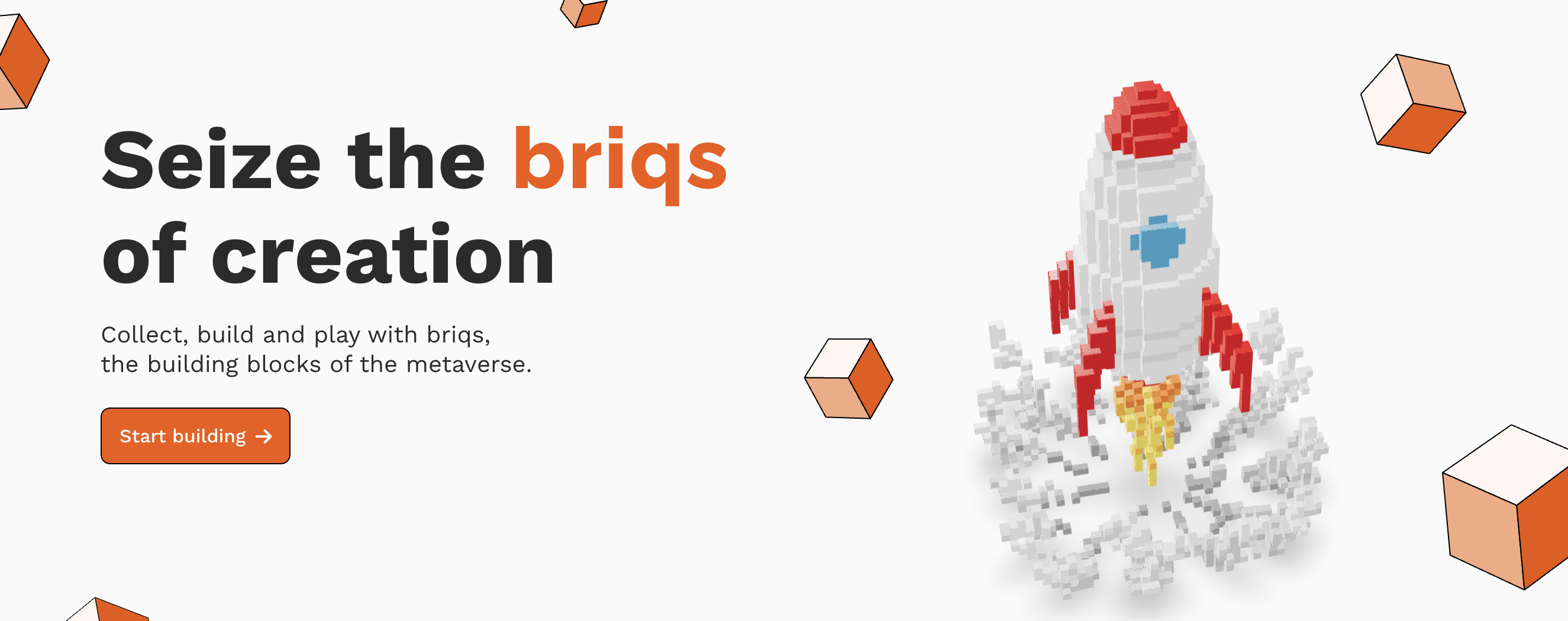
Due to its highly modular nature, it can be easily integrated into NFT and gaming projects, particularly in the Loot-centric Starknet ecosystem. Briq is also an active contributor to the Starknet ecosystem, as evidenced by its planned adoption by Dope Wars to establish a 3D voxel-based visual representation for NFTs.
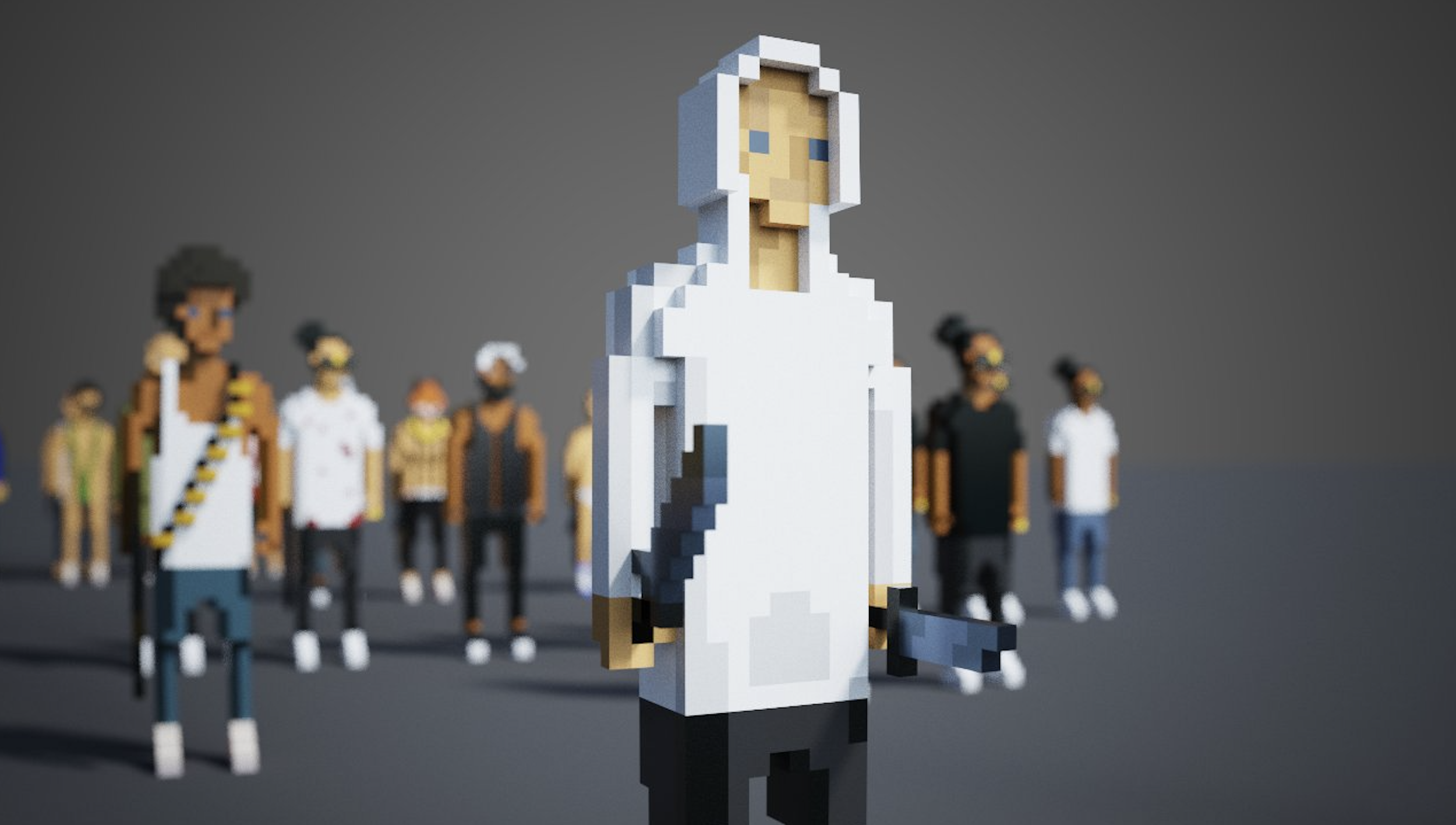
Briq recently achieved significant success in its collaboration with Argent's Xplorer, selling nearly 3 million Briqs and generating close to 450 ETH in revenue.
5.2.4 Influence
Influence is a game of considerable scope in terms of timeline, content, and economic mechanisms. Perhaps in the future, I will devote an article to offer a more detailed introduction.
In essence, Influence began to generate a vast random galaxy using smart contracts as early as 2018, but then remained dormant for a long time until its revival in February 2021. Subsequently, in March 2021, the idea of building a large-scale space strategy sandbox MMO game based on the galaxy, along with some game value settings, was proposed and launched on the Rinkeby testnet. Simultaneously, a collaboration with the game project Parallel was established, announcing interoperable experiences for Parallel assets within the game.
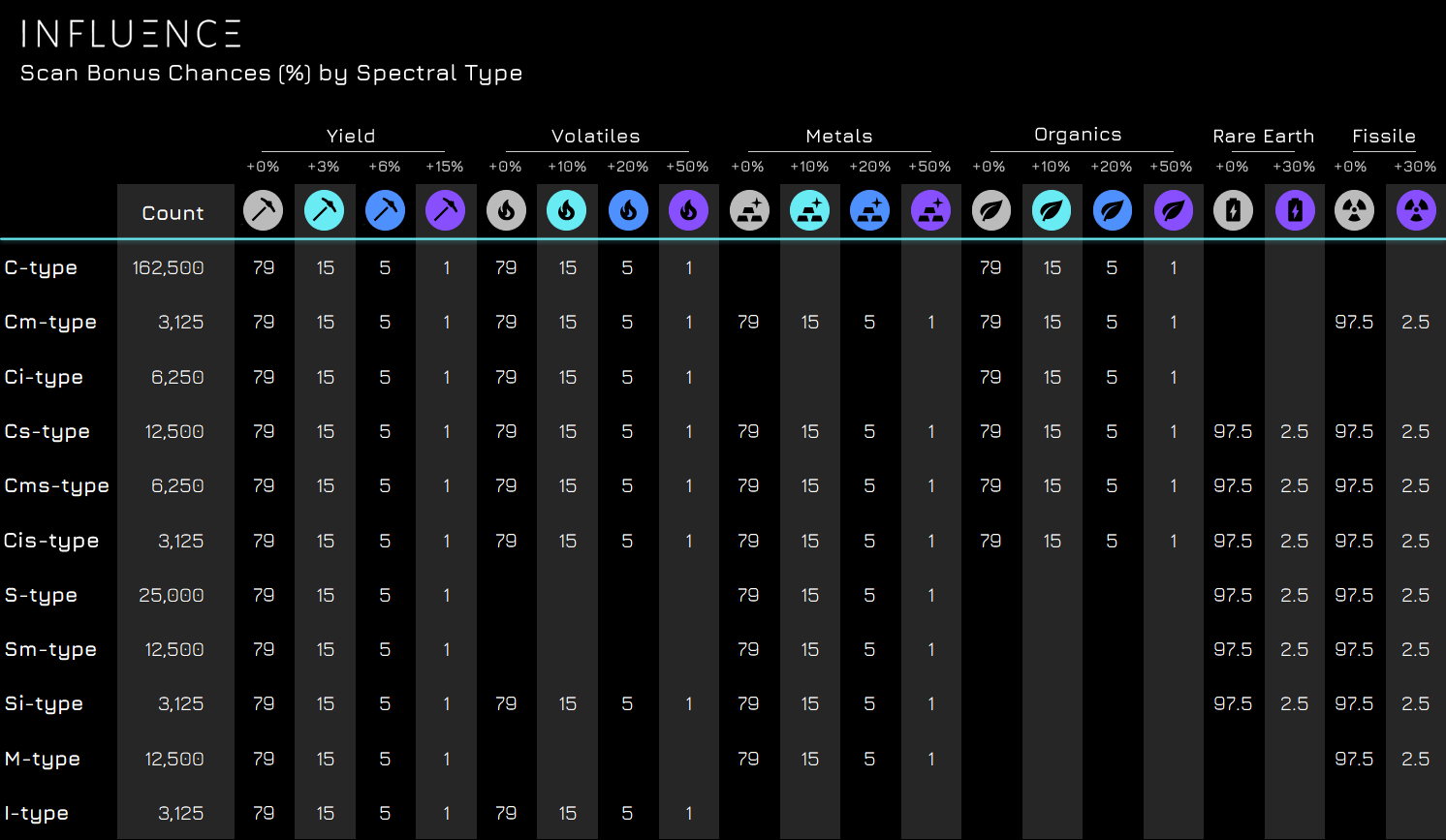
The game combines 4x, management simulators, and open-world RPG elements, allowing players to freely explore, crawl, build, and battle in the Adalia galaxy, constructing their own interstellar empire. All assets and core game logic are deployed on-chain.
Due to the large concept and scale, the game is divided into four stages: "Arrival Release," "Exploitation Release," "Discovery Release," and "Conflict Release." Currently, the game is still in the Arrival Release and is expected to enter the Exploitation Release in the summer of 2023.
Arrival Release was officially launched on April 17, 2021. In this release, the game completed the generation and distribution of core assets such as Asteroids NFT, Crew NFT, and SWAY tokens. In March 2022, the official 41-page game guide for the "Exploitation Release," was released, containing rich and comprehensive game mechanics and content settings that hold up well even when compared to traditional web2 games.
In August 2022, the team announced that they would launch on Starknet, and in March 2023, they held the final asset sale event "Prepare for Launch Sale" before the release of Exploitation Release, also unveiling the latest Tokenomics model.
In terms of community, there are already 14 third-party developer applications listed by the official team, including active projects within the Starknet ecosystem such as Guildly and Cartridge. Additionally, 6 projects received official grants. The Lores created by community members are also very rich, accumulating tens of thousands of words of text content with commendable quality.
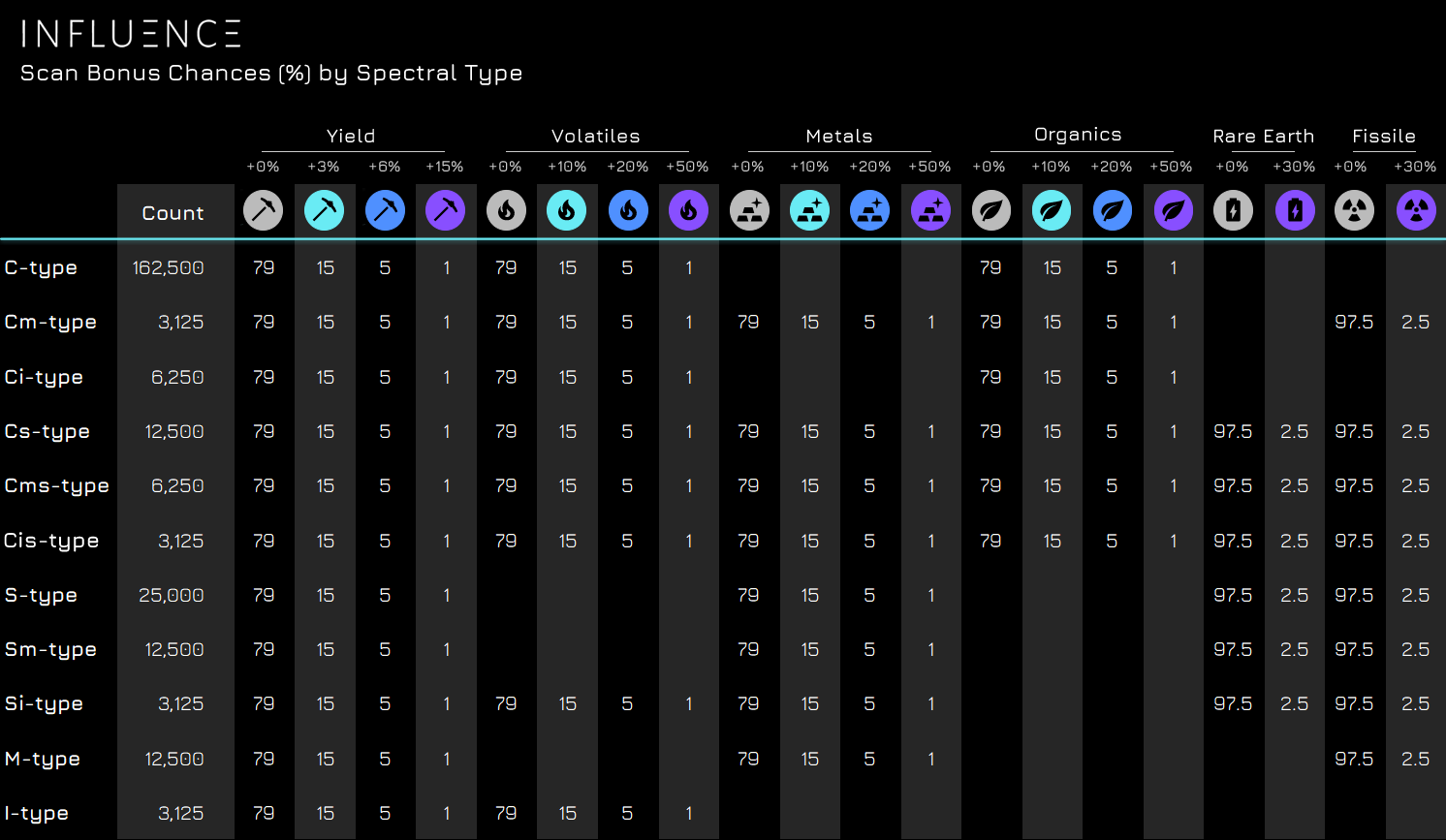
As a fully on-chain game, Influence can be considered an exceptional project in all aspects. With the introduction of Dojo, the official team is currently attempting to remake the game using Dojo. There is much anticipation for the in-game performance of the upcoming Exploitation Release.
5.2.5 Topology
Topology is a unique team founded by @guiltygyoza and @iamkunhokim. Unlike most teams currently focusing on fully on-chain games, engines, or other developer tools, they concentrate on the implementation of the underlying "rule/law layer" in the Autonomous World.
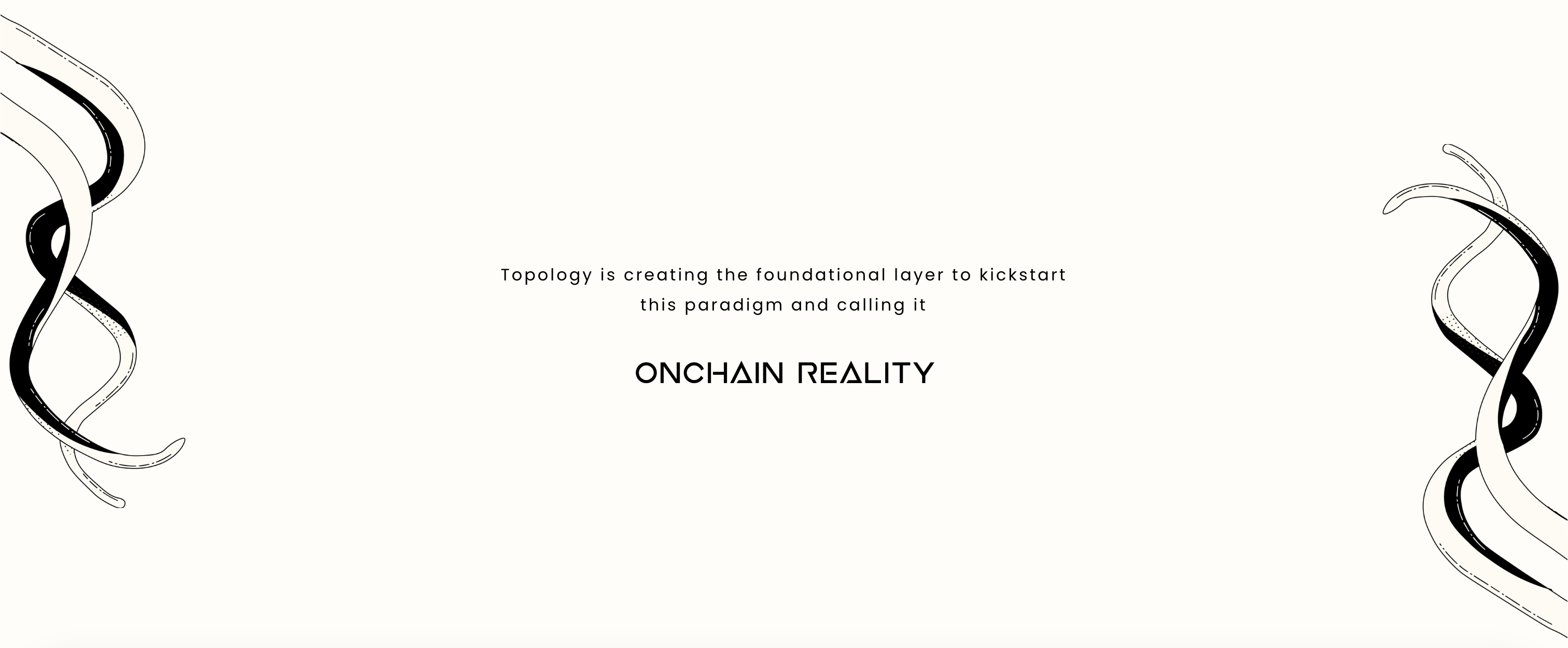
Topology believes that games fully developed on the blockchain are no longer confined to the definition of "games." Based on this limitless access and immutable nature, we can replicate or create rules similar to natural laws. These rules are not owned by any entity and treat all entities equally. Thus, when these underlying rules possess sufficient depth and complexity, fully on-chain games will be able to create an "on-chain reality," and Topology will dedicate itself to assisting in building this rule/law system.
This is undoubtedly a grand and avant-garde vision. From the current product form of Topology, it is already exploring in such direction, leaning more towards a fully on-chain physics engine. To date, Topology has launched 3 highly experimental projects, each of which carries the implementation of some on-chain rule or physical realization.
ISAAC is a cooperative construction game combining elements of "The Three-Body Problem" and "Factorio" and launched on June 24, 2022. Players form teams to enter a planet located in a three-body solar system, where they must collaborate to utilize the planet's resources to build propulsion systems (called NDPEs) and escape the environment to achieve victory. In ISAAC, the team has built a real-time physics model on-chain simulating the positions of the planet and the three suns, incorporating players' actions as parameters to increase the system's chaoticity and complexity, providing a highly immersive gaming experience.
Subsequently, on November 7, 2022, they launched MuMu, an algebraic digital physics simulator. With the addition of audio features in the second season, it has evolved into a command-based programmatic digital music generator, which lives on-chain.
Recently, at STARKTokyo in April 2023, the team announced their latest project, "Shoshin." It is a strategy-based battle game where players set Minds (battle thinking) for their Agents (characters), and the Agents will engage in battles based on these 'mind' rules, and each frame's decision and battle results will be verified and settled on-chain.
This unique 'rule' use case introduces a different dynamic to the fully on-chain gaming landscape, which is currently dominated by traditional RTS and SLG genres. The concept of Minds is reminiscent of learning to fight through a disk in 'The Matrix'.
However, Topology's goal extends far beyond just a game. The team is currently remaking the project using Cairo 1.0 and developing towards a highly modular, application-specific VM. Those interested can check out their introduction at STARKTokyo.
Shoshin is currently open for early Playtest applications, and it is well worth the effort to fill out the form and give it a try.
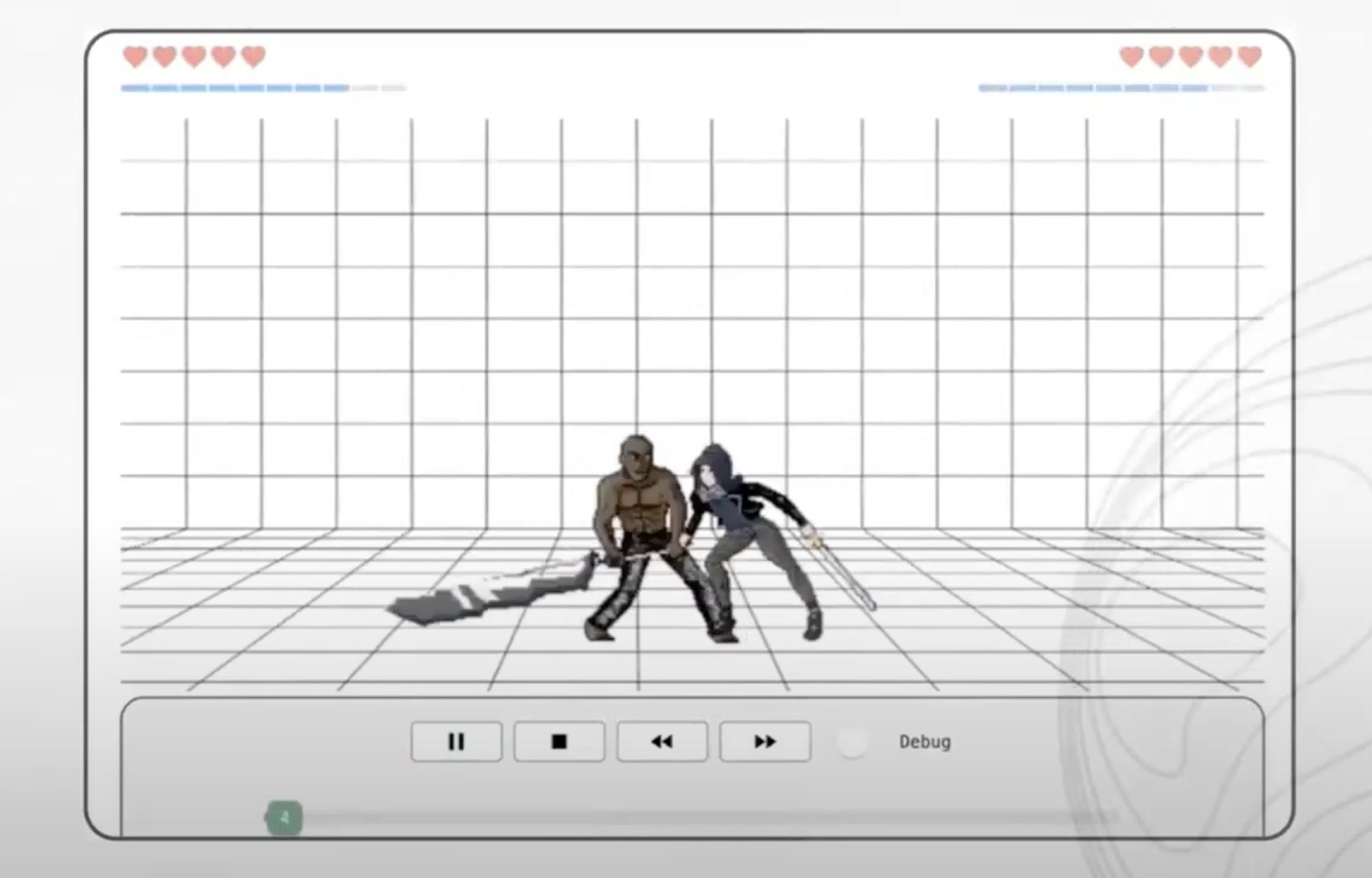
Besides the aforementioned projects focusing on game ecosystem development, there are many other active projects within the Starknet ecosystem worth noting. These include Madara, specializing in Sequencer; Kakarot, focusing on zkEVM; and Lambda Class, a significant ecosystem contributor. The latter three are also core contributors to the Dojo engine.
Lambda will also host the LambdaZKWeek Hackathon during ETHCC 2023, with sponsors including Dojo, Starknet, AZtech, Mina, among other official organizations. Interested parties should not miss this opportunity.
5.3 Inheritance of Dark Forest vs. Loot's: MUD vs. DOJO
By this point, the introductions to MUD and Dojo are nearly complete. Tracing their origins reveals that both are extensions of the two major starting points in fully on-chain gaming, inheriting each other's ethos and practicing their respective philosophies. I previously discussed the connection between the two in "The Ultimate Form of Blockchain Gaming: Exploring 'Fully On-Chain' through Dark Forest & Loot". Once again, comparing, contemplating, and observing the new works of both sides is an intriguing endeavor, bearing witness to the clash between different legacies.
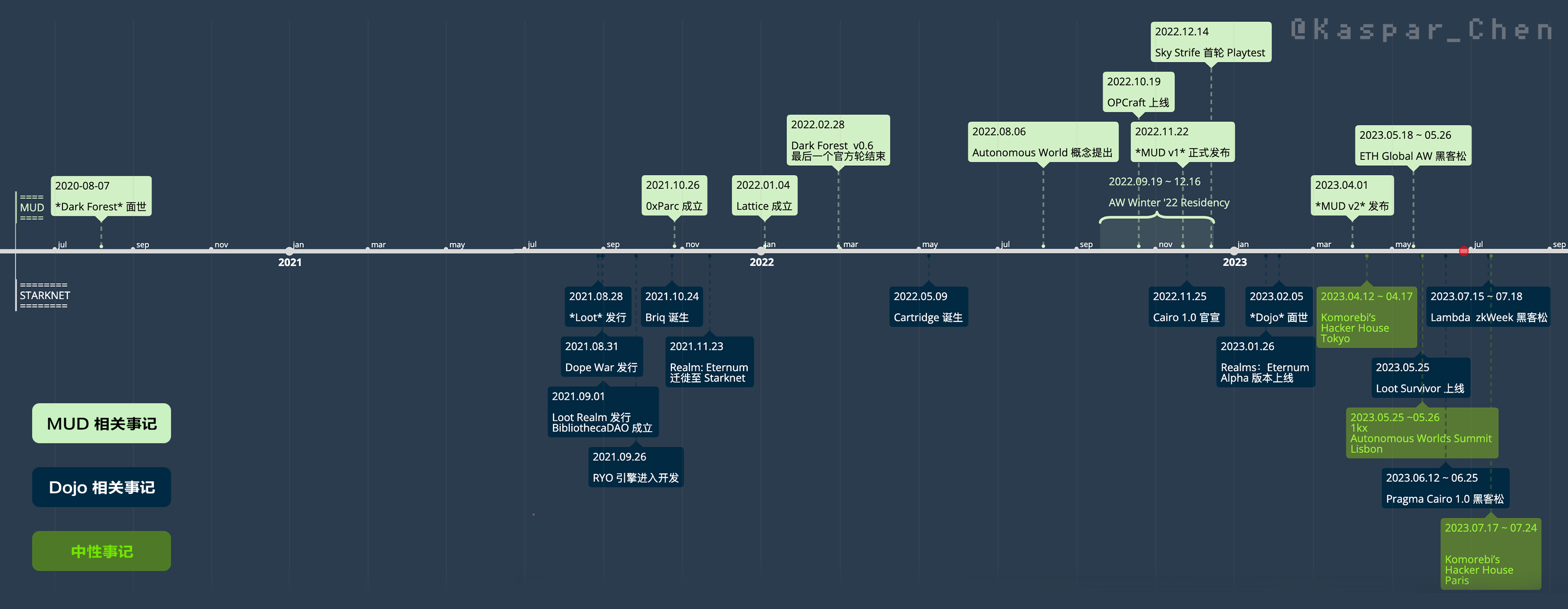
At this juncture, it wouldn't be satisfying to merely observe without comparing the two. Here, I will provide a simple and subjective comparison from three aspects: Behavior Style, Ecosystem Infrastructure, and Content Resources, representing only my limited perspective and knowledge.
Behavior Style
MUD, with its lineage from Dark Forest to 0xPARC to Lattice, as well as its solid ideological foundation, robust product philosophy, exceptional developer recruitment capabilities, and goals of building the underlying infrastructure, embodies the essence of a genuine Ethereum-based open-source project. On one hand, they construct narratives and disseminate ideas; on the other, they create in-house products as showcases and continuously host hackathons to attract developer contributions, ensuring a balanced focus on both thought and practice. So far, the results have been quite impressive.
If MUD represents Ethereum academism, then Dojo inherits the grassroots, unconventional approach of Loot's bottom-up philosophy. The fact that Dojo was initially drafted by three different projects indicates that its style leans more towards collaboration, mutual support, and unity among various projects and communities.
This is partly due to the relatively smaller number of Starknet ecosystem developers compared to Ethereum, and also because of the backing of Loot, an exceptional web3 native IP. Its strong inclusiveness and ability to connect different projects allow it to collaborate more freely with various project communities.
Ecosystem Infrastructure
The resources discussed here refer more to the ecosystem's resources, including content reserves, infrastructure development, and core developer attention.
From an infrastructure standpoint, the EVM ecosystem is undoubtedly more mature, with a wealth of tools and reference materials available for developers. However, since the overall development of the EVM ecosystem is more extensive, with numerous trending and competitive topics, the attention of the entire EVM ecosystem has not yet focused on this relatively early field of fully on-chain gaming.
For Starknet, on the other hand, there is relatively more emphasis on fully on-chain gaming, as its founder Eli Ben-Sasson has mentioned several times in his Montenegro speech. Therefore, Starknet will undoubtedly devote a higher proportion of its resources to supporting fully on-chain gaming in terms of infrastructure and resources. Meanwhile, Dojo's collaborative approach allows it to quickly leverage the power of different communities to create new scenarios and solutions. Currently, among Dojo's core contributors, developers from active Starknet infrastructure projects such as Madara and Kakarot can often be seen.
Content Resources
In terms of content, both sides have their respective strengths and challenges. For the EVM-based MUD, although ETH is the largest NFT distribution chain, most well-established IPs tend to operate independently, with limited external inclusiveness and interoperability, and a lower inclination to explore fully on-chain gaming and Autonomous Worlds. There is no effective way to connect and leverage these content resources, so MUD games generally have a smaller scale and focus more on game logic and turn-based gameplay.
For Starknet, the obvious advantage is the presence of Loot, a powerful content IP. Under the contributions and leadership of individuals like Timshel and loothero, Loot has already amassed a wealth of textual content and a foundation for collaborative storytelling. This will be very beneficial for new developers, who can spend less effort building games with a certain level of in-depth content.
In addition to Loot-based projects like Realm and Loot Survivor, independent projects such as Dope War and Influence also have deep and complete narrative content, making them more likely to attract in-depth players than MUD games.
However, the slightly awkward aspect is that, despite Loot's openness, there is a lack of documentation on content guidance and co-creation processes, making it difficult for many people to understand and utilize this part of the resources quickly. On the other hand, Dojo and Cairo's developer documentation still needs improvement, and frequent updates leave many developers with no time to focus on content creation.
Overall
In general, both sides have their strengths. MUD's advantages lie in its pure lineage and influence inside the developer community. The number of developers currently working on fully on-chain gaming based on MUD is undoubtedly much more than that of Dojo. As a result, more exciting ideas and innovative projects are likely to emerge. However, due to the limited content resources available, producing larger-scale games with deeper content layers may be difficult in the short term, as the involved content creation, economic mechanisms, and complex game logic all pose significant challenges to independent developers or small development teams.
However, I heard that CCP Games, the company behind EVE Online, is very interested in MUD and has begun working on a Web3 version of EVE, which may be developed using or partially utilizing MUD. According to the CEO, a playtest version is expected to launch in September. Additionally, 0xCitadel and ShatteredEON both have promising content, but since they have yet to launch, we can only look forward to them (neither are developed with MUD, but there may be collaboration opportunities in the future).
Starknet's advantage lies in its richer content IPs, including Loot, Dope War, Realm, Briq, and more, allowing developers to quickly incorporate their ideas. For example, the recent popular Loot Survivor has collaborated with Loot GA. Moreover, the Starknet ecosystem is more concentrated, providing more opportunities for developer communication and idea collision.
However, the problem is also apparent. Although the Cairo language has better performance, the underlying language is still in a phase of frequent updates and iterations, bringing uncertainty to development work.
VI. Conclusion
Regardless of the differences in style and resources between MUD and Dojo, they share a strikingly similar commonality: they naturally attract a considerable number of geeks and developers to contribute, think, and innovate within their ecosystems in different approaches based solely on the same vision of Autonomous World.
Taking a metaphor from a senior who deeply experienced DeFi Summer, @tianrangzhang: "The vibe of the Fully On-Chain Summit in Lisbon in May 2023 is basically like the defi.wtf Summit in October 2019. If L2, zkEVM, and zkVM are analogous to the alt L1s of that time, Axiom and Herodotus middleware can be compared to Link and GRT back then.
MUD, in terms of the application layer, is like Uniswap, significantly liberating content creators from technical constraints. A thousand meme coins in Uniswap correspond to a thousand small/meme games in MUD, and MUD's style and background resemble the orthodox and tokenless stance of UNI back then. Dojo, on the other hand, is more like Sushi/Aave, with a more grassroots and down-to-earth fair launch approach.
At the same time, looking back at the development history of traditional game engines, we can see a positive cycle: from introducing basic infrastructure to creating self-developed game examples, attracting developers to build ecosystems, producing hit games, and thus attracting more developers to participate. The formation and strengthening of such an ecosystem release tremendous energy and support the success of renowned commercial engines like Unity and Unreal Engine.
We can see that MUD and Dojo have already taken their own steps in different ways. Driven by this trend, it is easy to foresee the next generation of Unity and Unreal Engine for fully on-chain Autonomous Worlds.
The veil of the stage has been elevated, and as the grand spectacle unfolds, where will you be?
==============================================================
Appendix: References
Most references have already been linked within the article. Forgive me for any unintentional omissions.